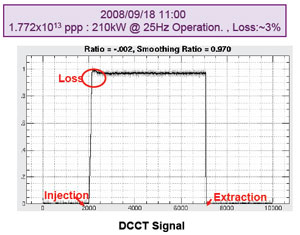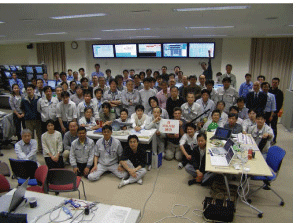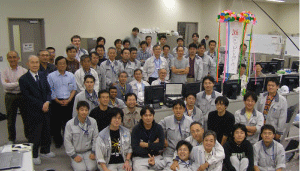![]() US-Japan Science and Technology Cooperation Project (High Energy Physics) Mini-Symposium and Joint Committee Meeting was held from April 22 (Thu) to 24 (Sat). (2021.5.26)
US-Japan Science and Technology Cooperation Project (High Energy Physics) Mini-Symposium and Joint Committee Meeting was held from April 22 (Thu) to 24 (Sat). (2021.5.26)
![]() The US-Japan mini-symposium on high-energy physics was held online from April 22 (Thu) to 24 (Sat). ---more
The US-Japan mini-symposium on high-energy physics was held online from April 22 (Thu) to 24 (Sat). ---more
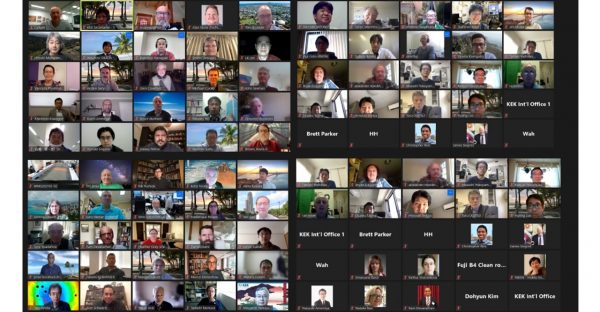
![]() The Asian Forum for Accelerators and Detectors “AFAD 2021” was held from March 16 (Tue.) to 18 (Thu.). (2021.3.24)
The Asian Forum for Accelerators and Detectors “AFAD 2021” was held from March 16 (Tue.) to 18 (Thu.). (2021.3.24)
![]() The Asian Forum for Accelerators and Detectors “AFAD 2021” was held from March 16 (Tue.) to 18 (Thu.).AFAD is a forum established in 2011 for the further development of collaboration and cooperation within the Asia-Oceania region in the fields of accelerator/detector and their related technologies/applications.Last year, the Forum was postponed due to the COVID-19 pandemic, but this time 204 participants from 8 countries/regions attended. ---more
The Asian Forum for Accelerators and Detectors “AFAD 2021” was held from March 16 (Tue.) to 18 (Thu.).AFAD is a forum established in 2011 for the further development of collaboration and cooperation within the Asia-Oceania region in the fields of accelerator/detector and their related technologies/applications.Last year, the Forum was postponed due to the COVID-19 pandemic, but this time 204 participants from 8 countries/regions attended. ---more
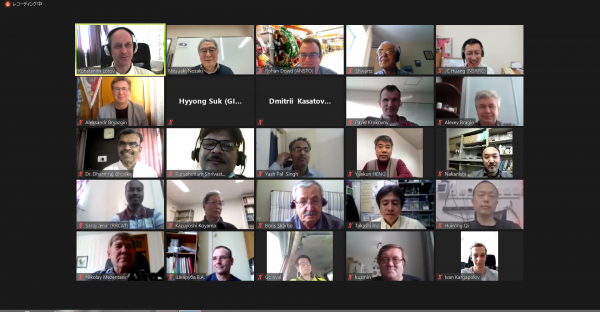
![]() The Announcement of the Next Director of J-PARC Center (2021.2.26)
The Announcement of the Next Director of J-PARC Center (2021.2.26)
![]() Prof. Takashi KOBAYASHI,
Prof. Takashi KOBAYASHI,
who is the current Head of Particle and Nuclear Physics Division, J-PARC Center/Deputy Director, Institute of Particle and Nuclear Studies, KEK, has been appointed as the next Director of J-PARC Center. This new appointment will be effective on the April 1, 2021 until March 31, 2024. ---more
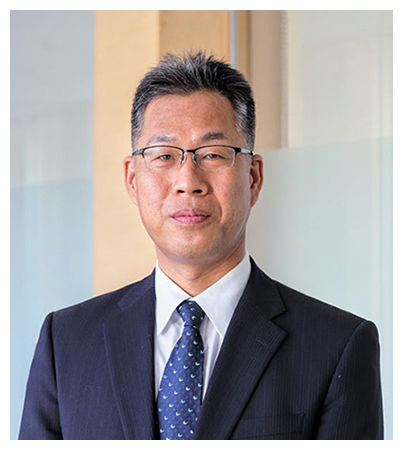
![]() The next Director of the Accelerator Laboratory determination (2020.11.27)
The next Director of the Accelerator Laboratory determination (2020.11.27)
![]() The Education and Research Council of KEK chose Tadashi Koseki as the next Director of the Accelerator Laboratory. ---more
The Education and Research Council of KEK chose Tadashi Koseki as the next Director of the Accelerator Laboratory. ---more
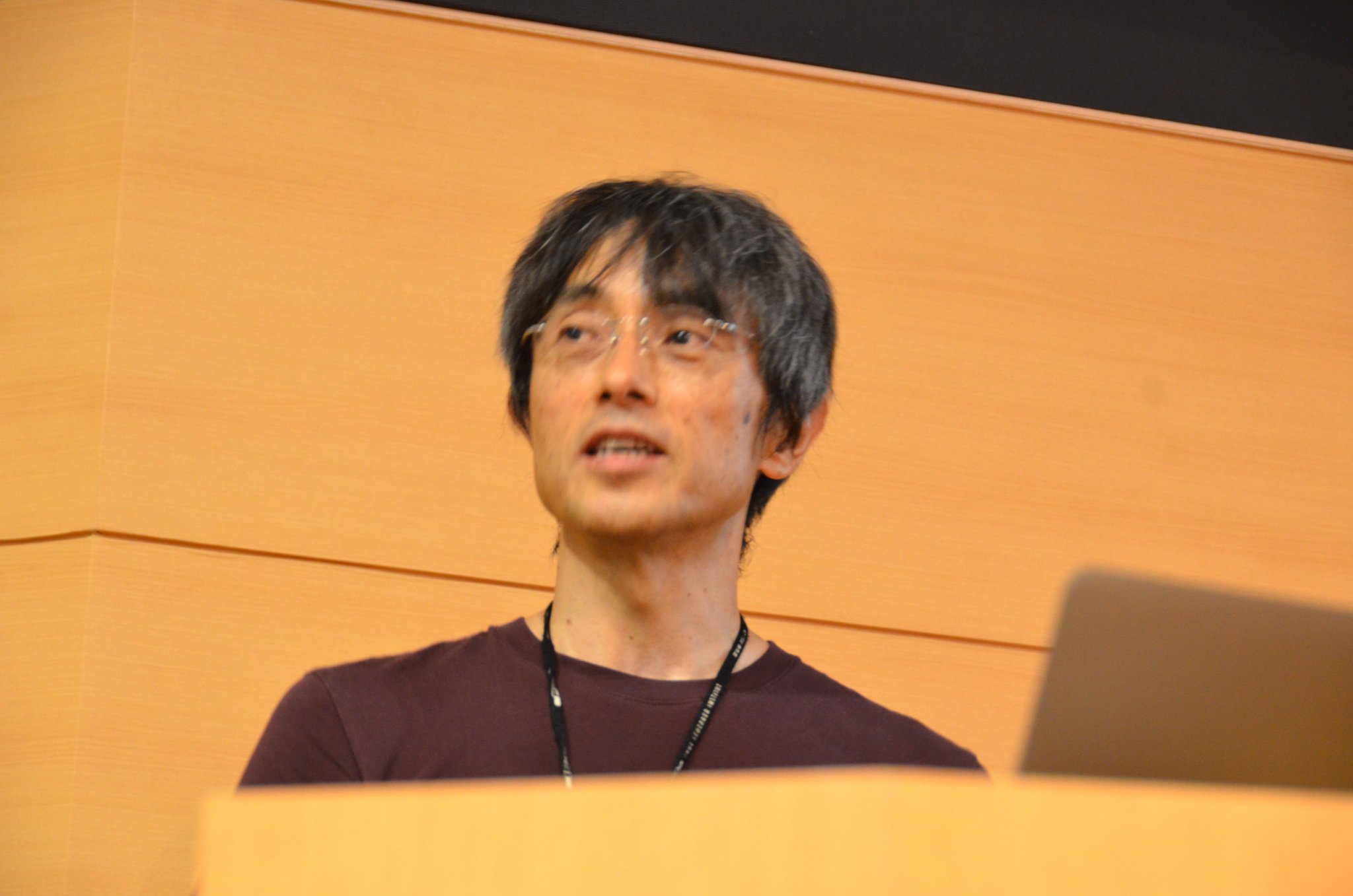
In order to describe the research strategy of KEK for 5 years (2014-2018), the current KEK roadmap was created in 2013, revised in 2016, and updated in 2019. KEK intends to renew the roadmap since the next KEK midterm target and plan period will start from April 2022. ---more
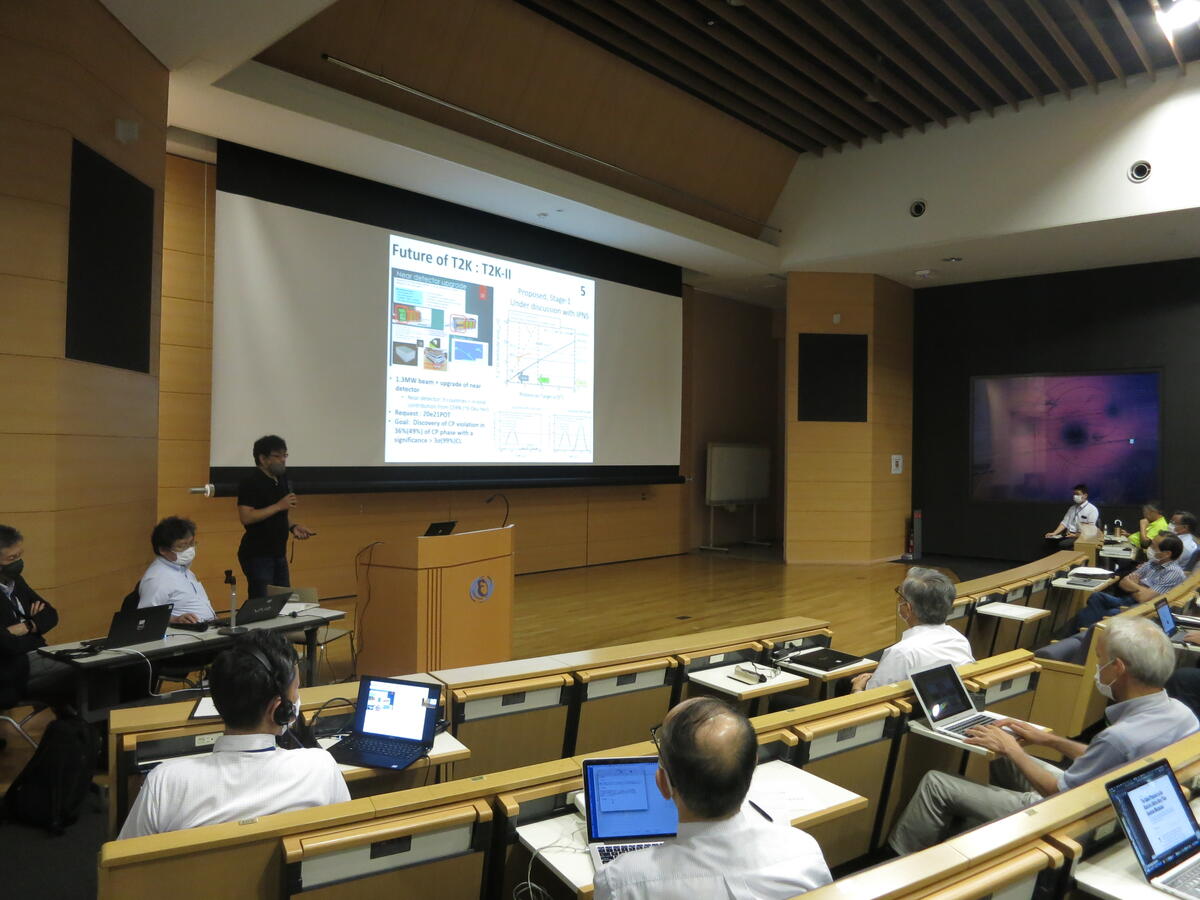
![]() SuperKEKB collider achieves the world's highest luminosity (2020.6.26)
SuperKEKB collider achieves the world's highest luminosity (2020.6.26)
![]() Japan’s High Energy Accelerator Research Organization (KEK) has been steadily improving the performance of its flagship electron-positron collider, SuperKEKB, since it produced its first electron-positron collisions in April 2018. At 20:34 on 15th June 2020, SuperKEKB achieved the world’s highest instantaneous luminosity for a colliding-beam accelerator, setting a record of 2.22×1034cm-2s-1. Previously, the KEKB collider, which was SuperKEKB’s predecessor and was operated by KEK from 1999 to 2010, had achieved the world’s highest luminosity, reaching 2.11×1034cm-2s-1. KEKB’s record was surpassed in 2018, when the LHC proton-proton collider at the European Organization for Nuclear Research (CERN) overtook the KEKB luminosity at 2.14×1034cm-2s-1. SuperKEKB’s recent achievement returns the title of world’s highest luminosity colliding-beam accelerator to KEK.(*)
Japan’s High Energy Accelerator Research Organization (KEK) has been steadily improving the performance of its flagship electron-positron collider, SuperKEKB, since it produced its first electron-positron collisions in April 2018. At 20:34 on 15th June 2020, SuperKEKB achieved the world’s highest instantaneous luminosity for a colliding-beam accelerator, setting a record of 2.22×1034cm-2s-1. Previously, the KEKB collider, which was SuperKEKB’s predecessor and was operated by KEK from 1999 to 2010, had achieved the world’s highest luminosity, reaching 2.11×1034cm-2s-1. KEKB’s record was surpassed in 2018, when the LHC proton-proton collider at the European Organization for Nuclear Research (CERN) overtook the KEKB luminosity at 2.14×1034cm-2s-1. SuperKEKB’s recent achievement returns the title of world’s highest luminosity colliding-beam accelerator to KEK.(*)
(*)The current record is 2.40×1034cm-2s-1, obtained at 00:53 JST on June 21st. ---more
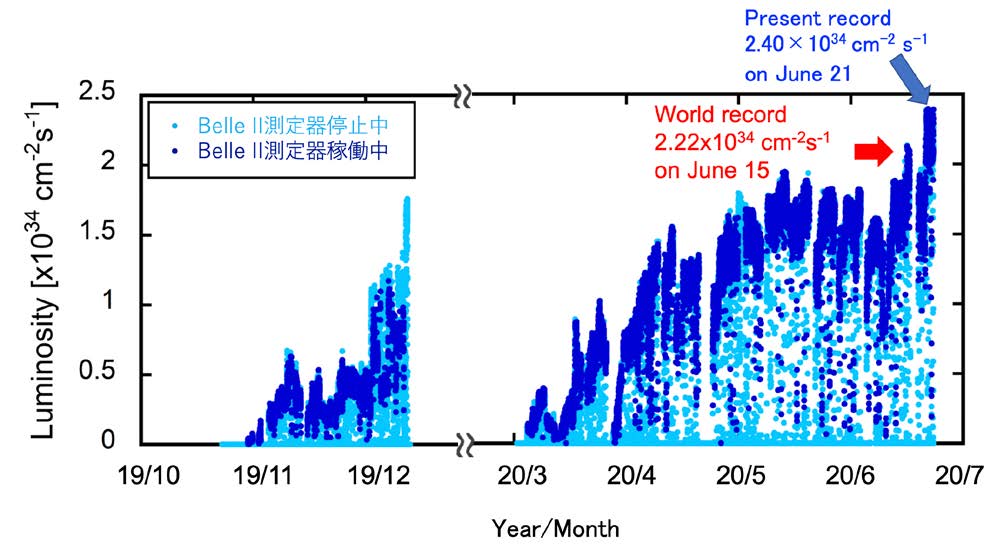
![]() "We are committed to making the ILC a success" - LCWS participants publish "Sendai Statement" in support of the International Linear Collider- (2019.11.1)
"We are committed to making the ILC a success" - LCWS participants publish "Sendai Statement" in support of the International Linear Collider- (2019.11.1)
![]() Scientists gathering in Sendai, Japan, for a scientific conference about a possible future particle physics projects to lead next generation of research following the Large Hadron Collider (LHC) at CERN in Geneva, Switzerland, reaffirmed their commitment to engage in the construction and scientific exploitation of the International Linear Collider (ILC) as a global project. ---more
Scientists gathering in Sendai, Japan, for a scientific conference about a possible future particle physics projects to lead next generation of research following the Large Hadron Collider (LHC) at CERN in Geneva, Switzerland, reaffirmed their commitment to engage in the construction and scientific exploitation of the International Linear Collider (ILC) as a global project. ---more
![]() KEK publishes the International Working Group's Recommendations for International Linear Collider (2019.10.2)
KEK publishes the International Working Group's Recommendations for International Linear Collider (2019.10.2)
![]() Tsukuba, Japan - 2 October 2019. KEK published a document on the recommendations for the International Linear Collider (ILC), a next-generation particle physics project, based on the report by the International Working Group on the ILC. The purpose of this document is to present some important aspects on implementation of the ILC project. ---more
Tsukuba, Japan - 2 October 2019. KEK published a document on the recommendations for the International Linear Collider (ILC), a next-generation particle physics project, based on the report by the International Working Group on the ILC. The purpose of this document is to present some important aspects on implementation of the ILC project. ---more
![]() STF-2 Beam Operation Demonstrates ILC Specifications (2019.5.28)
STF-2 Beam Operation Demonstrates ILC Specifications (2019.5.28)
![]() KEK’s Superconducting RF Test Facility (STF) operated the first beams during February and March 2019 and demonstrated results that satisfy the specifications for the International Linear Collider (ILC). ---more
KEK’s Superconducting RF Test Facility (STF) operated the first beams during February and March 2019 and demonstrated results that satisfy the specifications for the International Linear Collider (ILC). ---more
![]() ILC International Working Group Established -- First Meeting Held in Granada (2019.5.24)
ILC International Working Group Established -- First Meeting Held in Granada (2019.5.24)
![]() KEK established the International Working Group on the International Linear Collider (ILC) project to discuss issues such as international cost sharing. The First Meeting of the Working Group was held on Friday, 17 May, in Granada, Spain. ---more
KEK established the International Working Group on the International Linear Collider (ILC) project to discuss issues such as international cost sharing. The First Meeting of the Working Group was held on Friday, 17 May, in Granada, Spain. ---more
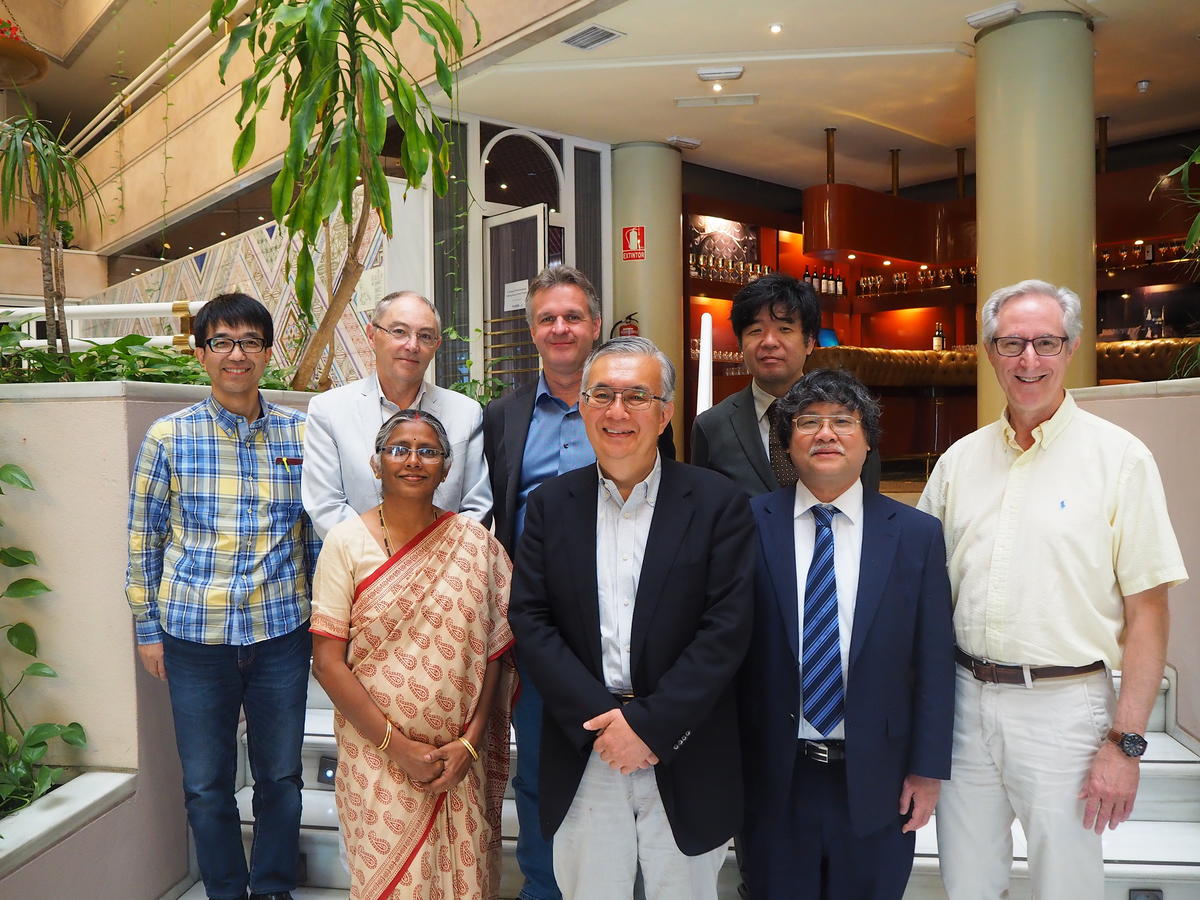
![]() To KEK users: Update on the fire in the accelerator structure assembly room at the electron-positron injector linac building (2019.4.26)
To KEK users: Update on the fire in the accelerator structure assembly room at the electron-positron injector linac building (2019.4.26)
INFO Dear KEK Users, The electron-positron injector linac has been brought back on line, with great support and assistance from many people in and outside KEK. ---more
![]() To KEK Users: On the fire in the accelerating structure assembly room at the electron-positron injector linac (2019.4.11)
To KEK Users: On the fire in the accelerating structure assembly room at the electron-positron injector linac (2019.4.11)
INFO Dear KEK Users,
We sincerely apologize for the great inconvenience and concern arising from this fire. We are also deeply appreciative of the understanding and offers of assistance. ---more
![]() Fire in the accelerator structure assembly room at electron-positron injector linac (2019.4.9)
Fire in the accelerator structure assembly room at electron-positron injector linac (2019.4.9)
![]() At 9:44 pm on April 3rd, on the KEK Tsukuba campus, a fire alarm went off in the accelerator structure assembly room at electron-positron injector linac (a general radiation area) and the fire department was called to the site.
At 9:44 pm on April 3rd, on the KEK Tsukuba campus, a fire alarm went off in the accelerator structure assembly room at electron-positron injector linac (a general radiation area) and the fire department was called to the site.
The cause of the alarm was determined to be an electric pulse modulator used in microwave power source, which had suffered a burnout. This event did not cause any human injuries or radiation leakage. We apologize to everyone for any concern or alarm. ---more
![]() Kick-off of the Belle II Phase 3 Physics Run (2019.3.26)
Kick-off of the Belle II Phase 3 Physics Run (2019.3.26)
![]() On March 25 19:44 (JST), 2019, electron-positron collisions have restarted at the SuperKEKB collider, and the Belle II experiment has now kicked off its physics data taking. Belle II is now fully instrumented with a state-of-the-art vertex detector, just in time for the start of the cherry blossom season in Japan.
---more
On March 25 19:44 (JST), 2019, electron-positron collisions have restarted at the SuperKEKB collider, and the Belle II experiment has now kicked off its physics data taking. Belle II is now fully instrumented with a state-of-the-art vertex detector, just in time for the start of the cherry blossom season in Japan.
---more
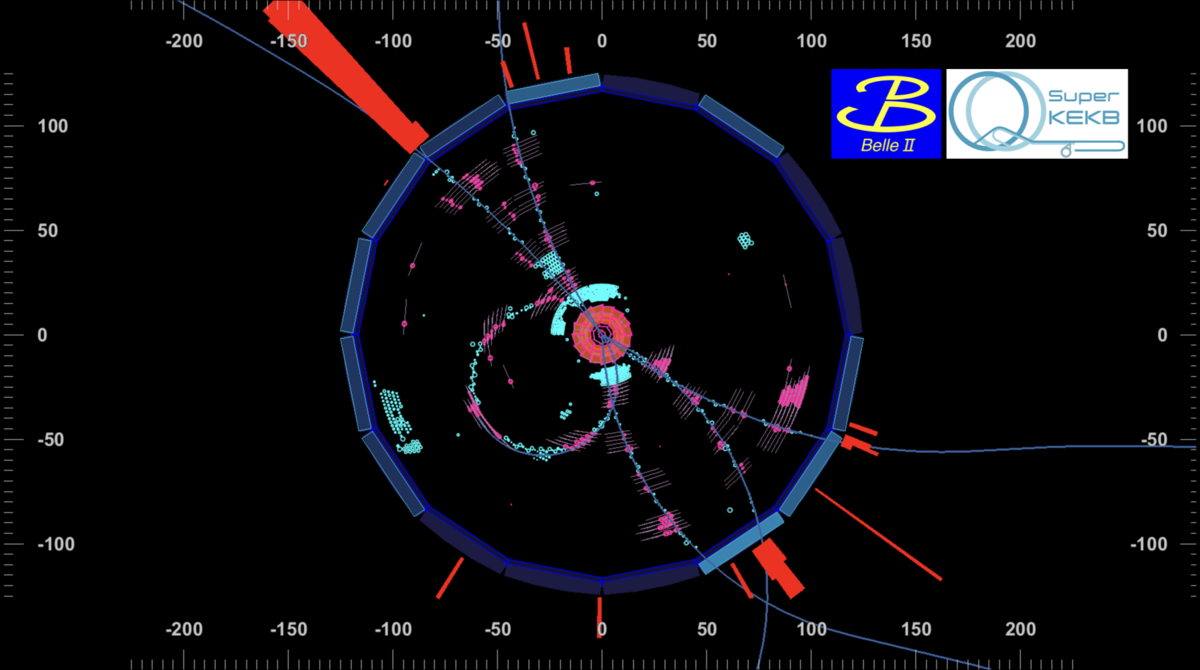
![]() SuperKEKB Phase 3 (Belle II Physics Run) Starts (2019.3.12)
SuperKEKB Phase 3 (Belle II Physics Run) Starts (2019.3.12)
![]() On March 11th, 2019, Phase 3 operation of the SuperKEKB project began successfully, marking a major milestone in the development of Japan’s leading particle collider. This phase will be the physics run of the project, in which the Belle II experiment will start taking data with a fully instrumented detector. ---more
On March 11th, 2019, Phase 3 operation of the SuperKEKB project began successfully, marking a major milestone in the development of Japan’s leading particle collider. This phase will be the physics run of the project, in which the Belle II experiment will start taking data with a fully instrumented detector. ---more
![]() Minuscule Gremlins Cause Vacuum Breakdown
Minuscule Gremlins Cause Vacuum Breakdown
in Radio-Frequency Accelerating Cavities (2019.1.22)
![]() Radio-frequency (RF) accelerating cavities (hereinafter referred to simply as RF cavities) are at the heart of many modern particle accelerators. An RF cavity is a metal resonator that can store high-energy microwaves to accelerate charged particles by the high-electric field of the stored microwaves. ---more
Radio-frequency (RF) accelerating cavities (hereinafter referred to simply as RF cavities) are at the heart of many modern particle accelerators. An RF cavity is a metal resonator that can store high-energy microwaves to accelerate charged particles by the high-electric field of the stored microwaves. ---more
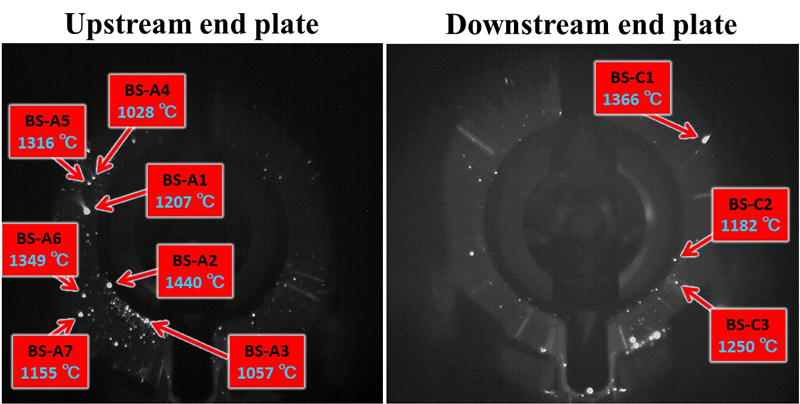
(![]() linked 2019.1.23)
linked 2019.1.23)
![]() Under Secretary for Science of U.S. DOE visited KEK (2018.10.24)
Under Secretary for Science of U.S. DOE visited KEK (2018.10.24)
![]() The Honorable Paul M. Dabbar, Under Secretary for Science of United States Department of Energy (DOE) visited KEK’s Tsukuba campus on October 9th. ---more
The Honorable Paul M. Dabbar, Under Secretary for Science of United States Department of Energy (DOE) visited KEK’s Tsukuba campus on October 9th. ---more
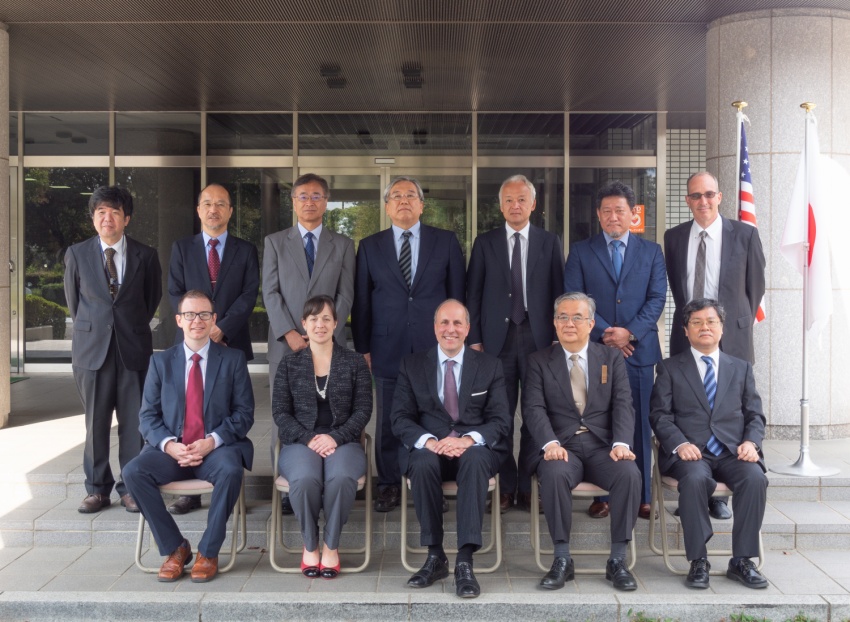
Electrons and Positrons Collide for the first time in the SuperKEKB Accelerator (2018.4.26)
![]() Electrons and positrons accelerated and stored by the SuperKEKB particle accelerator collided for the first time on 26 April 2018 0:38, GMT+09:00 at KEK in Tsukuba, Japan. The Belle II detector, installed at the collision point, recorded events from electron-positron annihilation (matter-antimatter annihilation) of the beam particles, which produced other particles likely including beauty quark and anti-beauty quark pairs as well as other hadronic and Bhabha scattering events1. ---more
Electrons and positrons accelerated and stored by the SuperKEKB particle accelerator collided for the first time on 26 April 2018 0:38, GMT+09:00 at KEK in Tsukuba, Japan. The Belle II detector, installed at the collision point, recorded events from electron-positron annihilation (matter-antimatter annihilation) of the beam particles, which produced other particles likely including beauty quark and anti-beauty quark pairs as well as other hadronic and Bhabha scattering events1. ---more
![]() SuperKEKB accelerator kicks into new gear (2018.3.28)
SuperKEKB accelerator kicks into new gear (2018.3.28)
![]() KEK has begun a new stage of operation of the SuperKEKB electron-positron collider, with a brand new positron damping ring and the Belle II detector. Electron and positron beams will begin colliding soon for the first time in 8 years, since the previous KEKB collider ceased its operations in 2010. ---more
KEK has begun a new stage of operation of the SuperKEKB electron-positron collider, with a brand new positron damping ring and the Belle II detector. Electron and positron beams will begin colliding soon for the first time in 8 years, since the previous KEKB collider ceased its operations in 2010. ---more

![]() The IHEP-KEK 2017 Collaboration Meeting held in Tsukuba (2017.9.29)
The IHEP-KEK 2017 Collaboration Meeting held in Tsukuba (2017.9.29)
![]() On September 7 and 8, ten delegation members led by Dr. Yifang WANG , Director of the Institute of High Energy Physics (IHEP), Chinese Academy of Sciences visited KEK Tsukuba campus to have a top-level collaboration meeting, which has a history of more than fifteen years. At the end of the meeting, both institutes signed a MoU for "R&D for high luminosity colliders ("MNPP-01 Project")" under the framework of Multinational Partnership Laboratory's Initiative. ---more
On September 7 and 8, ten delegation members led by Dr. Yifang WANG , Director of the Institute of High Energy Physics (IHEP), Chinese Academy of Sciences visited KEK Tsukuba campus to have a top-level collaboration meeting, which has a history of more than fifteen years. At the end of the meeting, both institutes signed a MoU for "R&D for high luminosity colliders ("MNPP-01 Project")" under the framework of Multinational Partnership Laboratory's Initiative. ---more
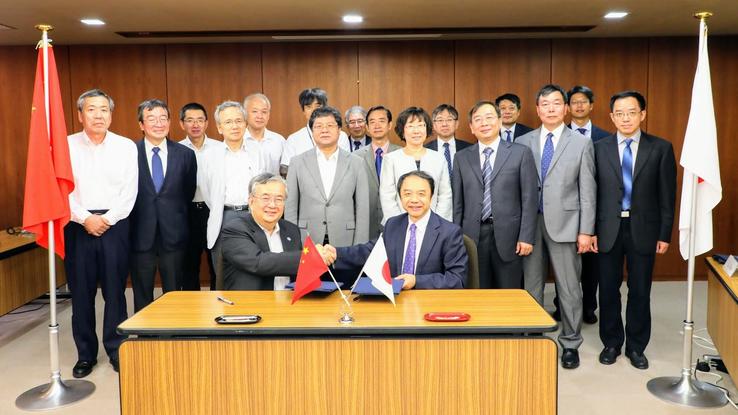
![]() The President of INFN in Italy Visit KEK Tsukuba to Discuss the Current and Future Collaboration (2017.9.13)
The President of INFN in Italy Visit KEK Tsukuba to Discuss the Current and Future Collaboration (2017.9.13)
![]() On August 31, 2017, Prof. Fernando Ferroni, President of the National Institute of for Nuclear Physics (INFN) in Italy visited KEK Tsukuba campus to discuss the current and future collaboration between INFN and KEK. KEK Director General, Dr. Masanori Yamauchi, Executive Director, Dr. Yasuhiro Okada, the KEK and Italian researchers working on Belle II and T2K experiments warmly welcomed the delegation. ---more
On August 31, 2017, Prof. Fernando Ferroni, President of the National Institute of for Nuclear Physics (INFN) in Italy visited KEK Tsukuba campus to discuss the current and future collaboration between INFN and KEK. KEK Director General, Dr. Masanori Yamauchi, Executive Director, Dr. Yasuhiro Okada, the KEK and Italian researchers working on Belle II and T2K experiments warmly welcomed the delegation. ---more
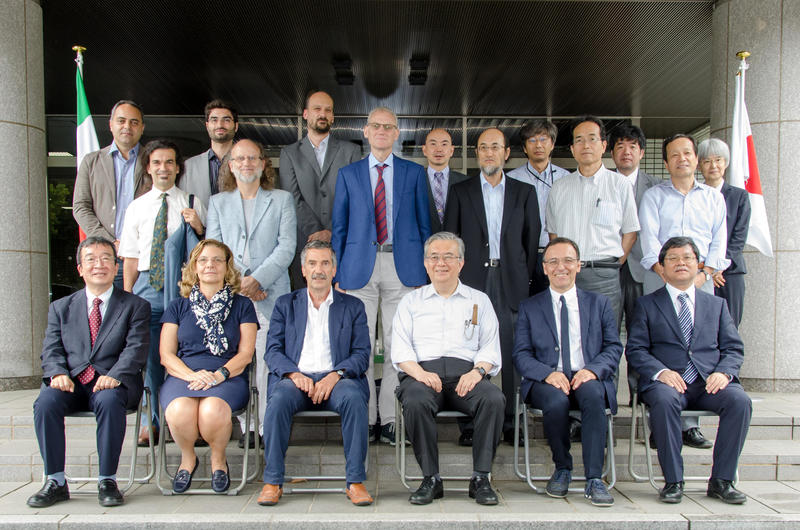
![]() The Belle II detector was "rolled-in" to the collision point of the SuperKEKB accelerator (2017.4.12)
The Belle II detector was "rolled-in" to the collision point of the SuperKEKB accelerator (2017.4.12)
![]() April 11th, 2017 The Belle II detector was "rolled-in" to the collision point of the SuperKEKB accelerator The High Energy Accelerator Research Organization (KEK) successfully completed the "roll-in" of the Belle II detector on the afternoon of Tuesday April 11th. ---more
April 11th, 2017 The Belle II detector was "rolled-in" to the collision point of the SuperKEKB accelerator The High Energy Accelerator Research Organization (KEK) successfully completed the "roll-in" of the Belle II detector on the afternoon of Tuesday April 11th. ---more
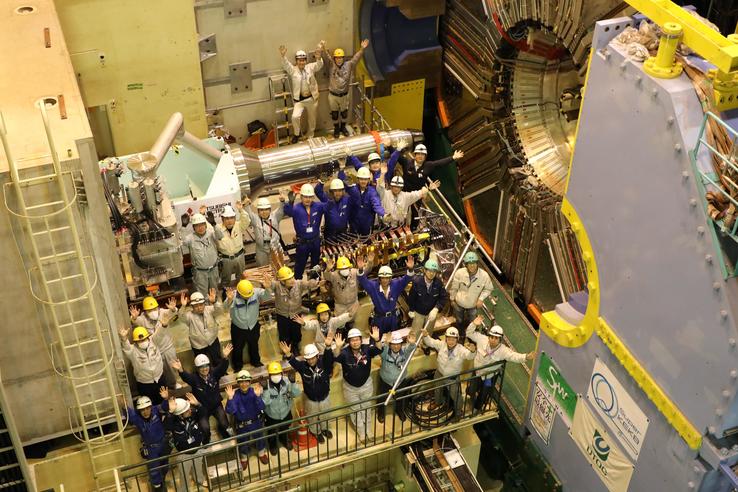
![]() Prof. Fumihiko Takasaki received the Japan Academy Prize from the Japan Academy (2017.2.23)
Prof. Fumihiko Takasaki received the Japan Academy Prize from the Japan Academy (2017.2.23)
![]() Dr. Fumihiko Takasaki, Professor Emeritus of KEK, received the Japan Academy Prize for his achievements in Studies of CP Violation in the B-Meson System. ---more
Dr. Fumihiko Takasaki, Professor Emeritus of KEK, received the Japan Academy Prize for his achievements in Studies of CP Violation in the B-Meson System. ---more
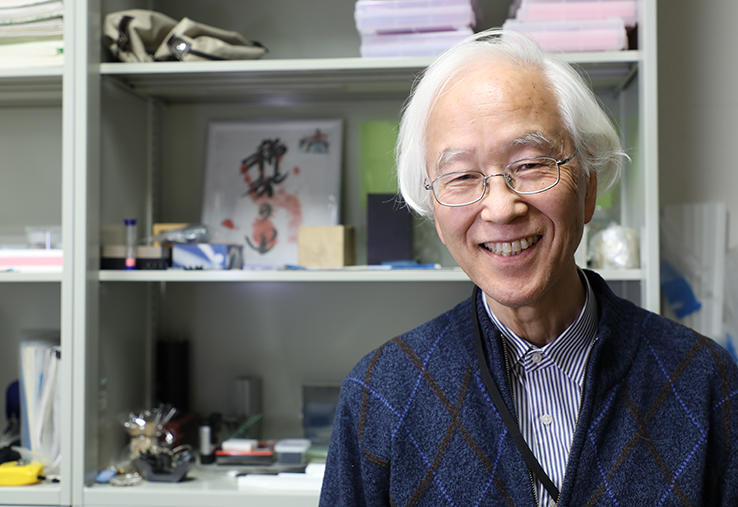
![]() Prof. Yoshitaka Kimura received the Order of the Sacred Treasure, Gold Rays with Neck Ribbon from Japanese Government (2016.12.14)
Prof. Yoshitaka Kimura received the Order of the Sacred Treasure, Gold Rays with Neck Ribbon from Japanese Government (2016.12.14)
![]() In the fall of 2016, Dr. Yoshitaka Kimura, Professor Emeritus of KEK, received the Order of the Sacred Treasure, Gold Rays with Neck Ribbon, from Japanese Government for his long term contribution in the field of education and research activities. ---more
In the fall of 2016, Dr. Yoshitaka Kimura, Professor Emeritus of KEK, received the Order of the Sacred Treasure, Gold Rays with Neck Ribbon, from Japanese Government for his long term contribution in the field of education and research activities. ---more
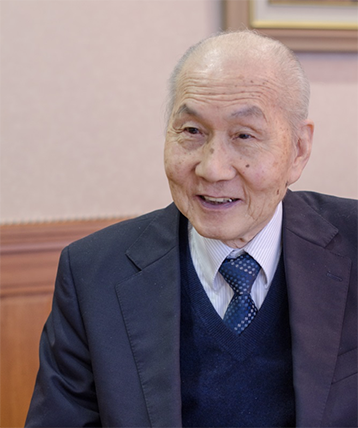
![]() Prof. Yong Ho Chin Appointed to the Chair of ICFA Beam Dynamics Panel (2016.11.17)
Prof. Yong Ho Chin Appointed to the Chair of ICFA Beam Dynamics Panel (2016.11.17)
![]() Prof. Yong Ho Chin of KEK Accelerator Laboratory was appointed to the new Chair of ICFA (International Committee for Future Accelerators) Beam Dynamics Panel. This panel is one of committees under ICFA and it aims to encourage and promote international collaborations on beam dynamics studies for present and future accelerators.
---more
Prof. Yong Ho Chin of KEK Accelerator Laboratory was appointed to the new Chair of ICFA (International Committee for Future Accelerators) Beam Dynamics Panel. This panel is one of committees under ICFA and it aims to encourage and promote international collaborations on beam dynamics studies for present and future accelerators.
---more
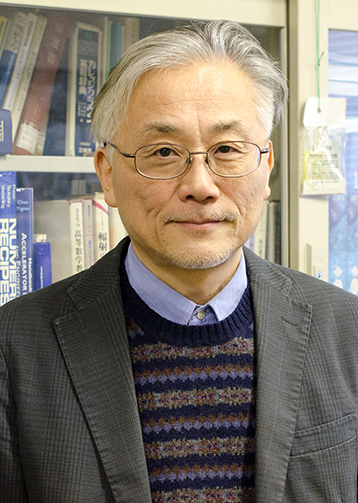
![]() The 3rd KEK Student Day held in KEK (2016.11.9)
The 3rd KEK Student Day held in KEK (2016.11.9)
![]() The 3rd KEK Student Day was held on October 25, 2016 at KEK Tsukuba campus. This event provides an opportunity for all graduate students studying at KEK to meet once a year. KEK hosts over one hundred graduate students of various universities including those of SOKENDAI. Each student presented his/her research at oral and poster sessions, that were followed by a panel discussion session entitled "Research experiences in abroad," in which foreign students from Asian countries and Japanese students exchanged the experiences about their research and life. ---more
The 3rd KEK Student Day was held on October 25, 2016 at KEK Tsukuba campus. This event provides an opportunity for all graduate students studying at KEK to meet once a year. KEK hosts over one hundred graduate students of various universities including those of SOKENDAI. Each student presented his/her research at oral and poster sessions, that were followed by a panel discussion session entitled "Research experiences in abroad," in which foreign students from Asian countries and Japanese students exchanged the experiences about their research and life. ---more
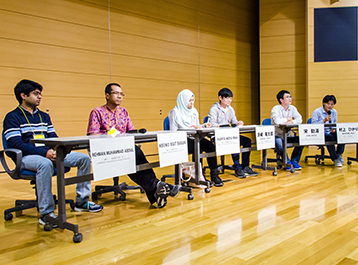
![]() Swedish delegation's visit to KEK (2016.10.17)
Swedish delegation's visit to KEK (2016.10.17)
![]() On October 5, 2016, a Swedish delegation, led by Prof. Viktor Öwall, Dean of the Faculty of Engineering, Lund University, visited the High Energy Accelerator Research Organization, KEK. The delegation also visited J-PARC on October 4, 2016. ---more
On October 5, 2016, a Swedish delegation, led by Prof. Viktor Öwall, Dean of the Faculty of Engineering, Lund University, visited the High Energy Accelerator Research Organization, KEK. The delegation also visited J-PARC on October 4, 2016. ---more
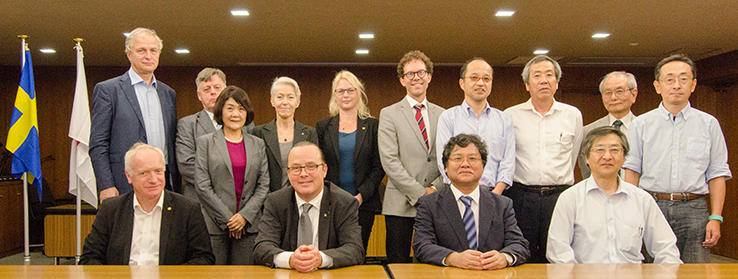
![]() The Prime Minister of the Republic of Slovenia visited KEK (2016.10.7)
The Prime Minister of the Republic of Slovenia visited KEK (2016.10.7)
![]() On October 4, 2016, His Excellency Dr. Miro Cerar, Prime Minister of the Republic of Slovenia, and Her Excellency Ms. Simona Leskovar, Ambassador of the Republic of Slovenia to Japan, visited the High Energy Accelerator Research Organization, KEK. H. E. Dr. Cerar and his delegation were warmly welcomed by Director General (DG), Dr. Masanori Yamauchi, Executive Director Dr. Yasuhiro Okada, the KEK and Slovenian researchers working on Belle/Belle II experiments. ---more
On October 4, 2016, His Excellency Dr. Miro Cerar, Prime Minister of the Republic of Slovenia, and Her Excellency Ms. Simona Leskovar, Ambassador of the Republic of Slovenia to Japan, visited the High Energy Accelerator Research Organization, KEK. H. E. Dr. Cerar and his delegation were warmly welcomed by Director General (DG), Dr. Masanori Yamauchi, Executive Director Dr. Yasuhiro Okada, the KEK and Slovenian researchers working on Belle/Belle II experiments. ---more
![]() Visual Imaging of Radio-Frequency Cavity Breakdown (2016.10.5)
Visual Imaging of Radio-Frequency Cavity Breakdown (2016.10.5)
![]() Toward the phase 2 operation of the SuperKEKB project, the construction of the positron damping ring (DR) has entered its final stage. In 2013, we published an article on the completion of the first production version of the radio-frequency (RF) accelerating cavity for the SuperKEKB/DR. The present article introduces the results of a high-power test of the second production version of the cavity. ---more
Toward the phase 2 operation of the SuperKEKB project, the construction of the positron damping ring (DR) has entered its final stage. In 2013, we published an article on the completion of the first production version of the radio-frequency (RF) accelerating cavity for the SuperKEKB/DR. The present article introduces the results of a high-power test of the second production version of the cavity. ---more
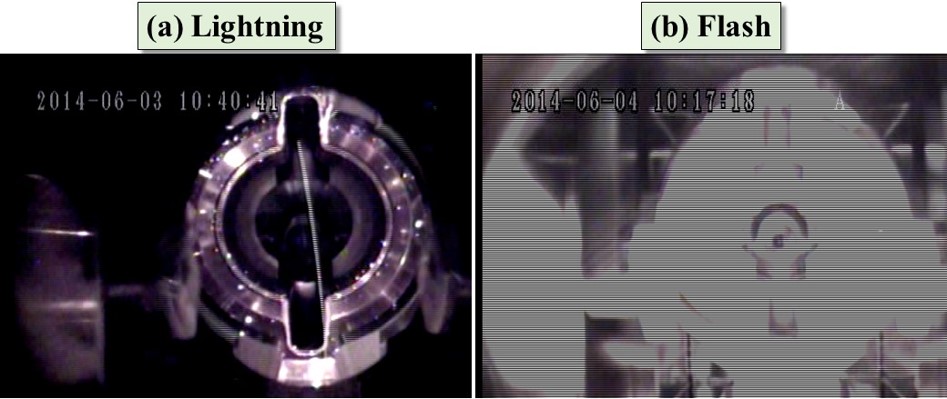
(![]() linked 2016.10.6)
linked 2016.10.6)
![]() A visit from the United States Embassy of Tokyo (2015.9.16)
A visit from the United States Embassy of Tokyo (2015.9.16)
![]() Mr. Jason P. Hyland, the Deputy Chief of Mission the United States Embassy of Tokyo visited the High Energy Accelerator Research Organization, KEK, on September 13, 2016 and met with Executive Director Dr. Yasuhiro Okada, KEK researchers and the United States researchers working on the Belle II Experiment. ---more
Mr. Jason P. Hyland, the Deputy Chief of Mission the United States Embassy of Tokyo visited the High Energy Accelerator Research Organization, KEK, on September 13, 2016 and met with Executive Director Dr. Yasuhiro Okada, KEK researchers and the United States researchers working on the Belle II Experiment. ---more
![]() KEK develops the KEK Project Implementation Plan (KEK-PIP) (2016.8.8)
KEK develops the KEK Project Implementation Plan (KEK-PIP) (2016.8.8)
![]() KEK has developed the KEK Project Implementation Plan (KEK-PIP). The KEK-PIP is an implementation plan which clarifies the framework of budgeting and priority projects to advance the research programs set out in the KEK Roadmap. ---more
KEK has developed the KEK Project Implementation Plan (KEK-PIP). The KEK-PIP is an implementation plan which clarifies the framework of budgeting and priority projects to advance the research programs set out in the KEK Roadmap. ---more
![]() The 21st meeting of the KEKB Accelerator Review Committee was held (2016.6.22)
The 21st meeting of the KEKB Accelerator Review Committee was held (2016.6.22)
![]() The 21st KEKB Accelerator Review Committee was held at Tsukuba campus from June 13 to 15. Present status of Phase 1 commissioning and status of preparation for Phase 2 and 3 were reported and discussed intensively. The committee members visited control room, ring tunnel, linac tunnel, dumping ring and QCS. ---more
The 21st KEKB Accelerator Review Committee was held at Tsukuba campus from June 13 to 15. Present status of Phase 1 commissioning and status of preparation for Phase 2 and 3 were reported and discussed intensively. The committee members visited control room, ring tunnel, linac tunnel, dumping ring and QCS. ---more
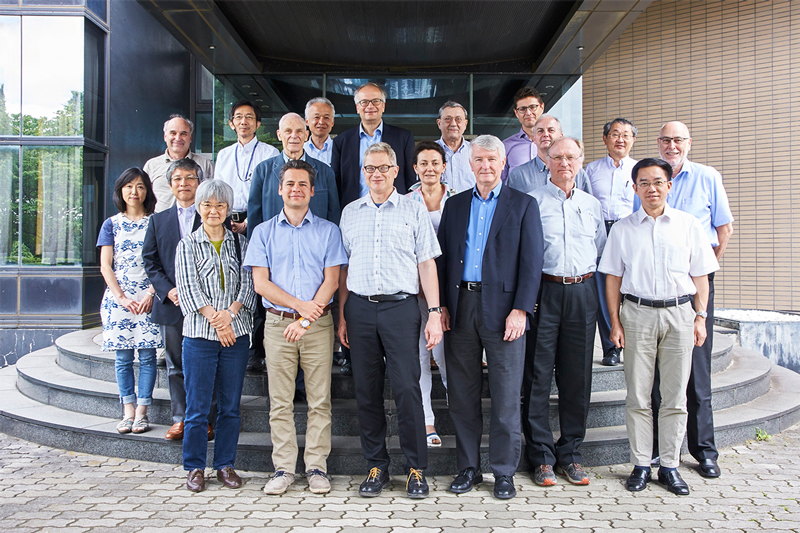
![]() First turns and successful storage of beams in the SuperKEKB electron and positron rings (2016.3.3)
First turns and successful storage of beams in the SuperKEKB electron and positron rings (2016.3.3)
![]() On February 1, 2016, the High Energy Accelerator Research Organization (KEK) started test operation of the SuperKEKB electron-positron collider. This machine represents a major upgrade from the previous KEKB accelerator, and is the culmination of years of construction that started in the second half of 2010. On February 10, SuperKEKB succeeded in circulating and storing a positron beam in the positron ring, and on February 26, succeeded in circulating and storing an electron beam in the electron ring as well. ---more
On February 1, 2016, the High Energy Accelerator Research Organization (KEK) started test operation of the SuperKEKB electron-positron collider. This machine represents a major upgrade from the previous KEKB accelerator, and is the culmination of years of construction that started in the second half of 2010. On February 10, SuperKEKB succeeded in circulating and storing a positron beam in the positron ring, and on February 26, succeeded in circulating and storing an electron beam in the electron ring as well. ---more
![]() Trial operation of SuperKEKB started (2016.2.23)
Trial operation of SuperKEKB started (2016.2.23)
![]() On February 1st, 2016, an electron beam was successfully transferred from the linac to the entrance of the main ring of the SuperKEKB electron-positron collider at KEK. In the days that followed, a beam of positrons was also transferred to the entry point of the main ring.Trial operation requires the adjustment of more than 2000 magnets in the electron and positron rings that are situated around the 3.1 kilometer circumference of SuperKEKB. ---more
On February 1st, 2016, an electron beam was successfully transferred from the linac to the entrance of the main ring of the SuperKEKB electron-positron collider at KEK. In the days that followed, a beam of positrons was also transferred to the entry point of the main ring.Trial operation requires the adjustment of more than 2000 magnets in the electron and positron rings that are situated around the 3.1 kilometer circumference of SuperKEKB. ---more
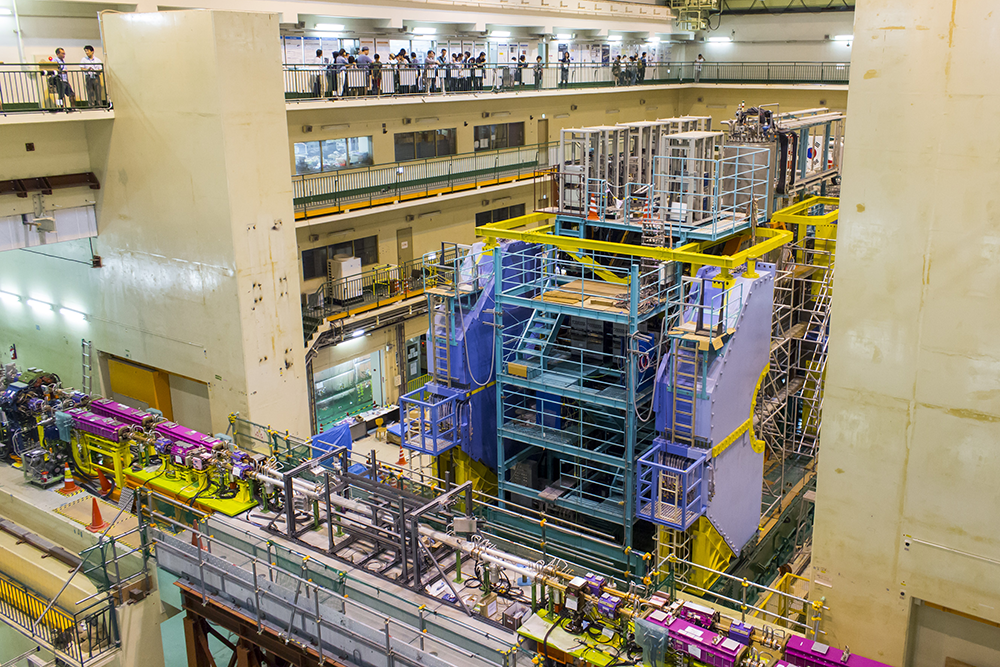
![]() TPS achieved the beam intensity of 520mA at NSRRC in Taiwan (2016.1.19)
TPS achieved the beam intensity of 520mA at NSRRC in Taiwan (2016.1.19)
![]() TPS (Taiwan Photon Source), a third generation light source accelerator at NSRRC (National Synchrotron Radiation Research Center), successfully achieved the beam intensity of 520 mA using a superconducting (SC) RF system of two KEKB-type SC-damped-cavities. The cavity has been developed under the close collaboration between the RF teams of KEK and NSRRC since 2010. This collaboration will be continued sharing the operation experience of both SuperKEKB and TPS, in order to establish the stable operation condition of SC-RF under the heavy beam loading. ---more
TPS (Taiwan Photon Source), a third generation light source accelerator at NSRRC (National Synchrotron Radiation Research Center), successfully achieved the beam intensity of 520 mA using a superconducting (SC) RF system of two KEKB-type SC-damped-cavities. The cavity has been developed under the close collaboration between the RF teams of KEK and NSRRC since 2010. This collaboration will be continued sharing the operation experience of both SuperKEKB and TPS, in order to establish the stable operation condition of SC-RF under the heavy beam loading. ---more
(![]() linked 2016.1.20)
linked 2016.1.20)
![]() KEK issues action plan for the International Linear Collider (2016.1.7)
KEK issues action plan for the International Linear Collider (2016.1.7)
![]() Japan's High Energy Accelerator Research Organization (KEK) issued an KEK-ILC action plan for how KEK should start its preparation toward the International Linear Collider when the Ministry of Education, Culture, Sports, Science and Technology (MEXT), decides to initiate negotiations with foreign countries.
---more
Japan's High Energy Accelerator Research Organization (KEK) issued an KEK-ILC action plan for how KEK should start its preparation toward the International Linear Collider when the Ministry of Education, Culture, Sports, Science and Technology (MEXT), decides to initiate negotiations with foreign countries.
---more
![]() KEK and TRIUMF signed a new partnership agreement (2015.12.21)
KEK and TRIUMF signed a new partnership agreement (2015.12.21)
![]() On Friday, December 4, 2015, KEK and TRIUMF signed a new partnership agreement to establish mutual TRIUMF and KEK offices. A signing ceremony was held at the Canadian Embassy in Japan, in the presence of Ambassador of Canada to Japan, His Excellency Mr. Mackenzie Clugston; Ms. Susan Bincoletto, Assistant Deputy Minister, International Business Development, and Chief Trade Commissioner, Global Affairs Canada; Ms. Yayoi Komatsu, Director-General, Research Promotion Bureau of Japan's Ministry of Education, Culture, Sports, Science and Technology (MEXT). ---more
On Friday, December 4, 2015, KEK and TRIUMF signed a new partnership agreement to establish mutual TRIUMF and KEK offices. A signing ceremony was held at the Canadian Embassy in Japan, in the presence of Ambassador of Canada to Japan, His Excellency Mr. Mackenzie Clugston; Ms. Susan Bincoletto, Assistant Deputy Minister, International Business Development, and Chief Trade Commissioner, Global Affairs Canada; Ms. Yayoi Komatsu, Director-General, Research Promotion Bureau of Japan's Ministry of Education, Culture, Sports, Science and Technology (MEXT). ---more
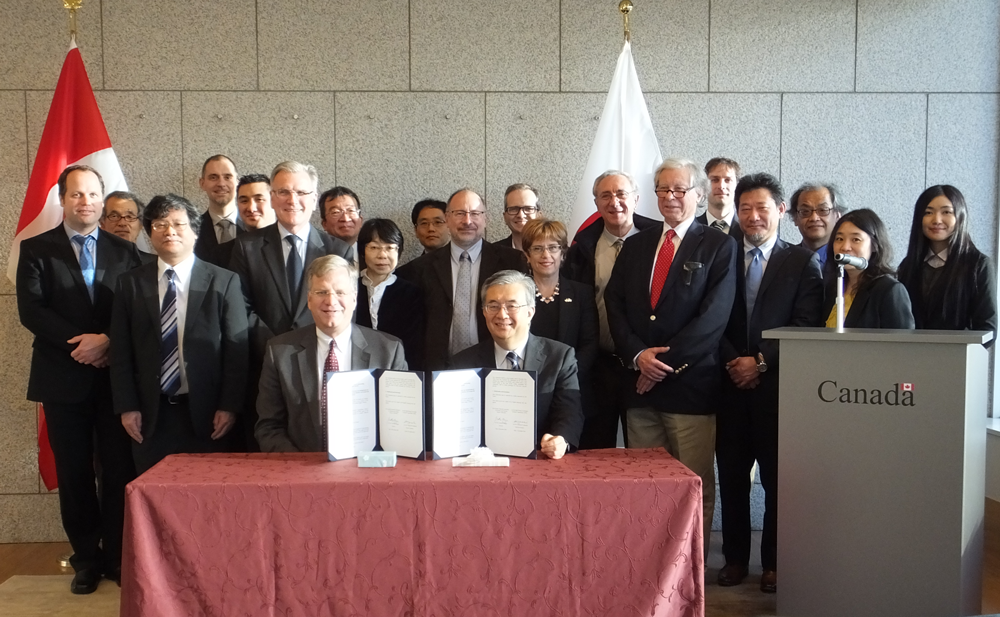
![]() The Indian Science and Technology Minister and the Ambassador of India visited KEK for 5 year extension of the Indian Beamline agreement (2015.11.20)
The Indian Science and Technology Minister and the Ambassador of India visited KEK for 5 year extension of the Indian Beamline agreement (2015.11.20)
![]() H.E. Dr. Harsh Vardhan, Hon'ble Union Minister for Science and Technology and Earth Science along with H.E. Smt. Deepa Gopalan Wadhwa, the Ambassador of India, Japan visited KEK on November 4, 2015. After a meeting with Dr. Masaharu Nomura, Executive Director of KEK and other executives to discuss ongoing cooperative activities in synchrotron radiation science and accelerator science, the signing ceremony for the five year extension of the Indian Beamline agreement was held in witness of Hon'ble Minister. ---more
H.E. Dr. Harsh Vardhan, Hon'ble Union Minister for Science and Technology and Earth Science along with H.E. Smt. Deepa Gopalan Wadhwa, the Ambassador of India, Japan visited KEK on November 4, 2015. After a meeting with Dr. Masaharu Nomura, Executive Director of KEK and other executives to discuss ongoing cooperative activities in synchrotron radiation science and accelerator science, the signing ceremony for the five year extension of the Indian Beamline agreement was held in witness of Hon'ble Minister. ---more
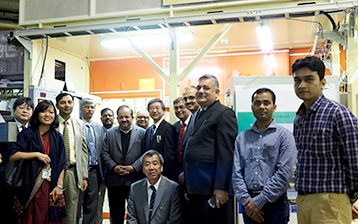
![]() Pioneering BaBar and Belle joint analysis (2015.8.19)
Pioneering BaBar and Belle joint analysis (2015.8.19)
![]() Almost all physical phenomena are the same for particles and their anti-particle partners - a property referred to as 'CP-symmetry'. CP violation occurs when this symmetry is broken so that nature behaves differently for particles and their anti-particle partners. CP violation has been observed in a small number of rare decays and a new case of CP violation has been reported in a first-ever joint data analysis with BaBar and Belle data. This joint analysis reveals the observation of CP violation in the two-body neutral B meson decays to neutral D meson and a light neutral meson for the first time. This analysis is the first attempt to utilize the data accumulated by two B-factories, BaBar and Belle experiments in a combined analysis that have, in the past, carried out independent measurements of CP violation in various B meson decays. To our knowledge, this is the first time competing particle physics experiments at different accelerators have combined their data in a single analysis prior to publication. ---more
Almost all physical phenomena are the same for particles and their anti-particle partners - a property referred to as 'CP-symmetry'. CP violation occurs when this symmetry is broken so that nature behaves differently for particles and their anti-particle partners. CP violation has been observed in a small number of rare decays and a new case of CP violation has been reported in a first-ever joint data analysis with BaBar and Belle data. This joint analysis reveals the observation of CP violation in the two-body neutral B meson decays to neutral D meson and a light neutral meson for the first time. This analysis is the first attempt to utilize the data accumulated by two B-factories, BaBar and Belle experiments in a combined analysis that have, in the past, carried out independent measurements of CP violation in various B meson decays. To our knowledge, this is the first time competing particle physics experiments at different accelerators have combined their data in a single analysis prior to publication. ---more
![]() First look at antineutrino appearance from T2K (2015.7.28)
First look at antineutrino appearance from T2K (2015.7.28)
[IPNS Topics] Scientists of the T2K collaboration observe three candidate electron antineutrino events at Super-Kamiokande in the muon antineutrino beam from J-PARC ---more
![]() A visit from the German Embassy to Japan in Tokyo at KEK (2015.7.14)
A visit from the German Embassy to Japan in Tokyo at KEK (2015.7.14)
![]() Dr. Stefan Moebs, the Minister Counselor, and Dr. Andreas Kirchner, the Science Counselor, from the German Embassy to Japan in Tokyo visited the KEK high energy physics laboratory on Wednesday, June 24th, 2015 and met with Director General (D.G.) Prof. Masanori Yamauchi and German researchers working on the Belle II experiment. After a greeting from the D.G., Executive Director Prof. Yasuhiro Okada gave an overview of KEK. Prof. Christian Kiesling of the Max Planck Institute for Physics in Munich then gave the German ministers an introduction to particle physics and the Belle II experiment at KEK. ---more
Dr. Stefan Moebs, the Minister Counselor, and Dr. Andreas Kirchner, the Science Counselor, from the German Embassy to Japan in Tokyo visited the KEK high energy physics laboratory on Wednesday, June 24th, 2015 and met with Director General (D.G.) Prof. Masanori Yamauchi and German researchers working on the Belle II experiment. After a greeting from the D.G., Executive Director Prof. Yasuhiro Okada gave an overview of KEK. Prof. Christian Kiesling of the Max Planck Institute for Physics in Munich then gave the German ministers an introduction to particle physics and the Belle II experiment at KEK. ---more
![]() A visit from the Italian Ambassador to Japan at KEK (2015.7.1)
A visit from the Italian Ambassador to Japan at KEK (2015.7.1)
![]() The Italian Ambassador in Tokyo, H.E. Domenico Giorgi, visited the KEK laboratory on Tuesday, June 23, and met with Director General Prof. Masanori Yamauchi. After the meeting, a Memorandum of Understanding between INFN and KEK was signed for the construction of the Belle II detector, which will be installed on the SuperKEKB accelerator. ---more
The Italian Ambassador in Tokyo, H.E. Domenico Giorgi, visited the KEK laboratory on Tuesday, June 23, and met with Director General Prof. Masanori Yamauchi. After the meeting, a Memorandum of Understanding between INFN and KEK was signed for the construction of the Belle II detector, which will be installed on the SuperKEKB accelerator. ---more
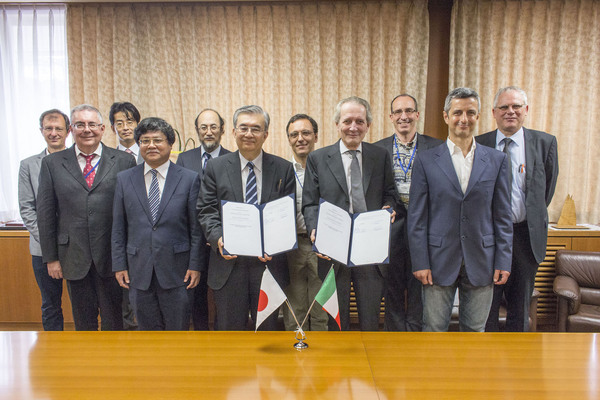
![]() Dr. Xudong Wang received the 2015 Encourage Prize of the Cryogenic and Superconductivity Society of Japan, CSSJ (2015.6.8)
Dr. Xudong Wang received the 2015 Encourage Prize of the Cryogenic and Superconductivity Society of Japan, CSSJ (2015.6.8)
![]() Dr. Xudong Wang in the KEK Accelerator Laboratory was awarded the 2015 Encourage Prize of CSSJ. The prizes is given to the researcher under 35 years old who belongs to CSSJ, and has the possibility of the remarkable contribution in the academic and technical fields of the cryogenic and superconductivity engineering, or actively presents the papers and the research talks in the journal and the conference of CSSJ. ---more
Dr. Xudong Wang in the KEK Accelerator Laboratory was awarded the 2015 Encourage Prize of CSSJ. The prizes is given to the researcher under 35 years old who belongs to CSSJ, and has the possibility of the remarkable contribution in the academic and technical fields of the cryogenic and superconductivity engineering, or actively presents the papers and the research talks in the journal and the conference of CSSJ. ---more
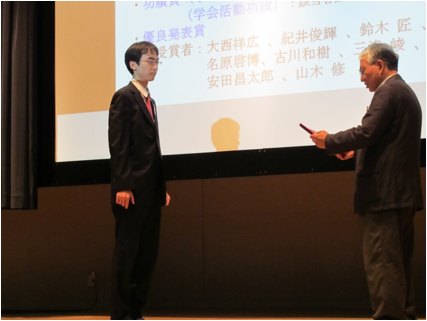
(![]() linked 2015.6.11)
linked 2015.6.11)
![]() Prof. E. Forest of KEK publishes a new textbook for beam dynamics (2015.4.2)
Prof. E. Forest of KEK publishes a new textbook for beam dynamics (2015.4.2)
![]() Prof. E. Forest of KEK is publishing his new textbook "From Tracking Code to Analysis ---Generalised Courant-Snyder theory for realistic accelerator models—" for beam dynamics from Springer. ---more
Prof. E. Forest of KEK is publishing his new textbook "From Tracking Code to Analysis ---Generalised Courant-Snyder theory for realistic accelerator models—" for beam dynamics from Springer. ---more
![]() KEK Director General's Address (2015.4.1)
KEK Director General's Address (2015.4.1)
![]() Particle accelerator has played extremely important roles in progress of our understanding of nature, since its history started in 1930's. It has provided essential methodology to study nuclei, elementary particles, condensed matter and even life sciences. Also, role of particle accelerators is really outstanding in their industrial and medical applications. There is no doubt that progress of particle accelerators has substantially contributed to the modern science. Technologies of particle accelerators are still advancing rapidly, and drive frontier of science and applied research. ---more
Particle accelerator has played extremely important roles in progress of our understanding of nature, since its history started in 1930's. It has provided essential methodology to study nuclei, elementary particles, condensed matter and even life sciences. Also, role of particle accelerators is really outstanding in their industrial and medical applications. There is no doubt that progress of particle accelerators has substantially contributed to the modern science. Technologies of particle accelerators are still advancing rapidly, and drive frontier of science and applied research. ---more
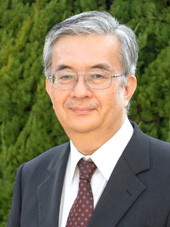
![]() New Executive Board Members Started A Three-Year Term at KEK (2015.4.1)
New Executive Board Members Started A Three-Year Term at KEK (2015.4.1)
![]() Fiscal year of KEK started on April 1, 2015, and a team of new management started their three-year term appointment this week. ---more
Fiscal year of KEK started on April 1, 2015, and a team of new management started their three-year term appointment this week. ---more
![]() The next Director of the Accelerator Laboratory determination (2014.12.25)
The next Director of the Accelerator Laboratory determination (2014.12.25)
![]() On December 24, the Education and Research Council of KEK chose Seiya Yamaguchi as the next Director of the Accelerator Laboratory. ---more
On December 24, the Education and Research Council of KEK chose Seiya Yamaguchi as the next Director of the Accelerator Laboratory. ---more

![]() Prof. Yong Ho Chin received the 2015 APS Outstanding Referee Award (2014.12.9)
Prof. Yong Ho Chin received the 2015 APS Outstanding Referee Award (2014.12.9)
![]() Prof. Yong Ho Chin of KEK Accelerator Laboratory was selected as an Outstanding Referee of 2015 for the Physical Review and Physical Review Letters journals published by American Physical Society (APS). This program has started in 2008 to recognize outstanding referees who are helpful to advance and diffuse the knowledge of physics, while creating a resource for the physics community in the APS journals. About 150 scientists are selected in each year among more than world-wide 52,000 referees. ---more
Prof. Yong Ho Chin of KEK Accelerator Laboratory was selected as an Outstanding Referee of 2015 for the Physical Review and Physical Review Letters journals published by American Physical Society (APS). This program has started in 2008 to recognize outstanding referees who are helpful to advance and diffuse the knowledge of physics, while creating a resource for the physics community in the APS journals. About 150 scientists are selected in each year among more than world-wide 52,000 referees. ---more

(![]() linked 2014.12.9)
linked 2014.12.9)
![]() New International Offices of KEK and CERN (2014.11.25)
New International Offices of KEK and CERN (2014.11.25)
![]() KEK and CERN have agreed to establish mutual offices at the respective labs: a CERN office at KEK and a KEK office at CERN, to facilitate and enhance common work on future accelerator projects and other related scientific projects of common interest. ---more
KEK and CERN have agreed to establish mutual offices at the respective labs: a CERN office at KEK and a KEK office at CERN, to facilitate and enhance common work on future accelerator projects and other related scientific projects of common interest. ---more
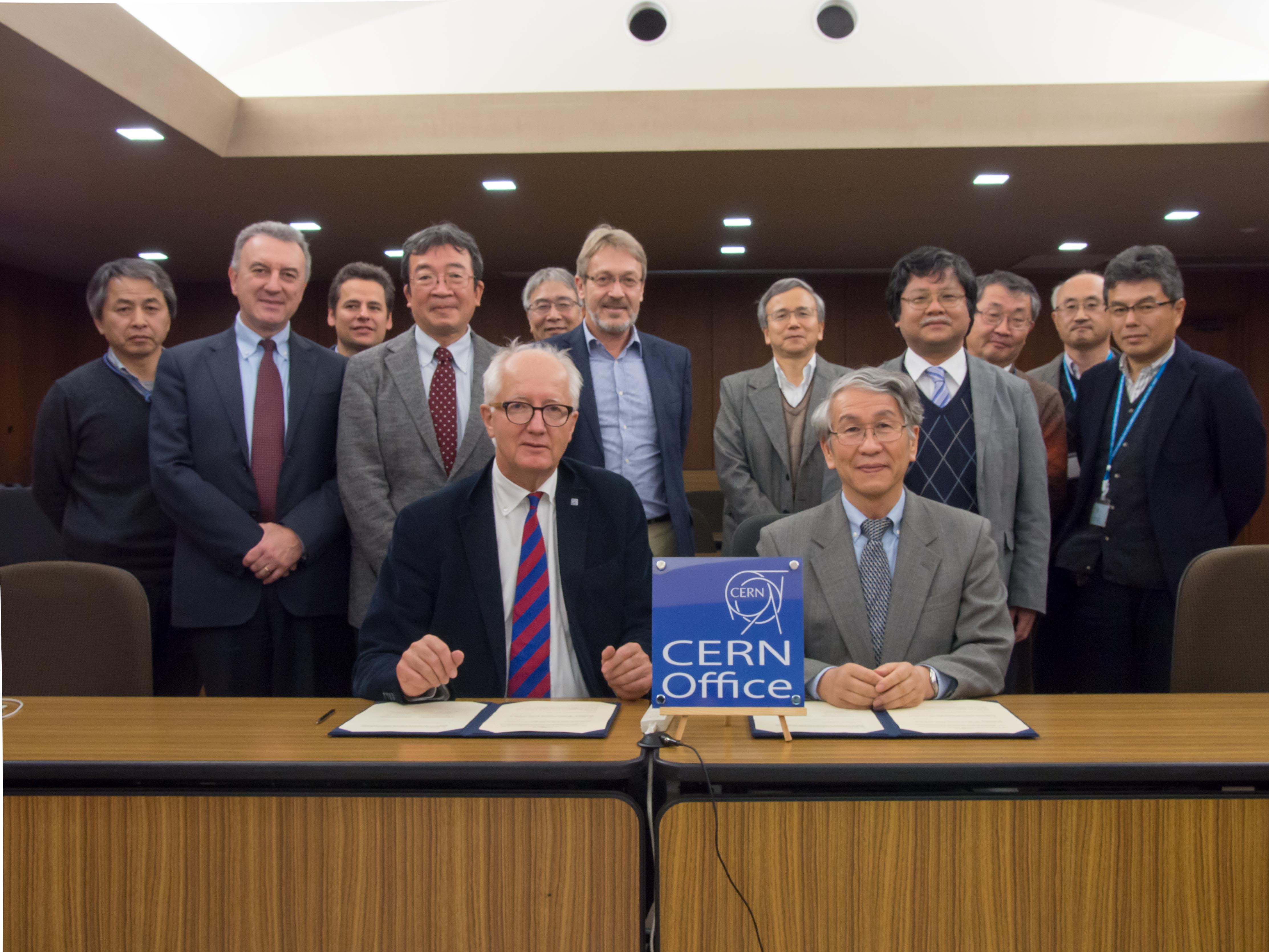
![]() KEK Openhouse 2014 to be held (2014.9.12)
KEK Openhouse 2014 to be held (2014.9.12)
Events KEK will be holding this year's openhouse.
The invitation is open to all the general public. Various facilities and research equipment will be on display. Lectures by leading scientists and gaming corners are prepared. ---more
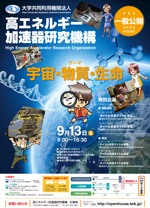
![]() From ICFA:International committee looks toward a global future of particle physics discoveries (2014.7.25)
From ICFA:International committee looks toward a global future of particle physics discoveries (2014.7.25)
![]() A global strategy for particle physics is taking shape, one world region at a time. Featuring colliders that smash particles at higher energies than ever before, and gigantic experiments to study the smallest components of matter, this future will lead to breakthrough discoveries at facilities around the globe.
A global strategy for particle physics is taking shape, one world region at a time. Featuring colliders that smash particles at higher energies than ever before, and gigantic experiments to study the smallest components of matter, this future will lead to breakthrough discoveries at facilities around the globe.
The International Committee for Future Accelerators (ICFA), an international body that facilitates international collaboration in the construction and use of particle accelerators for high-energy physics, has issued a statement that endorses the strategic plans for the future of high-energy physics in Europe, Asia and the United States. In parallel with efforts to globally pursue the study of neutrinos, ICFA has stated its continuing support of the International Linear Collider (ILC) and its encouragement of international studies of future circular colliders. ---more
![]() 50 years from the Discovery of "CP-violation"
50 years from the Discovery of "CP-violation"
- Belle and Babar complete the Joint Book on their experimental work to prove the Kobayashi-Maskawa theory of CP-violation - (2014.7.11)
![]() Joint publication of Belle and BaBar has comleted last month. To celebrate this achivement, the first special editions of the book are presented to Drs. Cronin, Kobayashi and Maskawa at the conference held in London.
Joint publication of Belle and BaBar has comleted last month. To celebrate this achivement, the first special editions of the book are presented to Drs. Cronin, Kobayashi and Maskawa at the conference held in London.
(Report from the Organizers of the conference, 50 YEARS OF CP VIOLATION) ---more
![]() Three researchers of ACCL have received Outstanding Referee Award since 2009 (2014.3.10)
Three researchers of ACCL have received Outstanding Referee Award since 2009 (2014.3.10)
![]() American Physical Society (APS) has started Outstanding Referee Program since 2008 to recognize scientists who have been exceptionally helpful in assessing manuscripts for publication in the APS journals. About 150 scientists are nominated in each year among more than 60,000 referees. At KEK Accelerator Laboratory (ACCL), Prof. Kazuhito Ohmi (2008), Prof. Kaoru Yokoya (2009), and Director Katsunobu Oide (2014) have been awarded so far. ---more
American Physical Society (APS) has started Outstanding Referee Program since 2008 to recognize scientists who have been exceptionally helpful in assessing manuscripts for publication in the APS journals. About 150 scientists are nominated in each year among more than 60,000 referees. At KEK Accelerator Laboratory (ACCL), Prof. Kazuhito Ohmi (2008), Prof. Kaoru Yokoya (2009), and Director Katsunobu Oide (2014) have been awarded so far. ---more

![]() Report on the Joint US-CERN-Japan-Russia Accelerator School 2013 (2013.12.9)
Report on the Joint US-CERN-Japan-Russia Accelerator School 2013 (2013.12.9)
![]() The Joint US-CERN-Japan-Russia Accelerator School 2013 was held at the Fuji Institute of Education and Training which is located at the foot of Mt. Fuji, one of the world heritages, from October 23 to 31, 2013. The school welcomes more than 100 attendees from many countries of Asia, Europe and North America, and successfully completed. ---more
The Joint US-CERN-Japan-Russia Accelerator School 2013 was held at the Fuji Institute of Education and Training which is located at the foot of Mt. Fuji, one of the world heritages, from October 23 to 31, 2013. The school welcomes more than 100 attendees from many countries of Asia, Europe and North America, and successfully completed. ---more
(![]() linked 2013.12.9)
linked 2013.12.9)
![]() Successful development of a 500-m-long laser-based fiducial line for high precision alignment of long-distance linear accelerators (2013.10.28)
Successful development of a 500-m-long laser-based fiducial line for high precision alignment of long-distance linear accelerators (2013.10.28)
![]() A research group led by Tsuyoshi Suwada, an associate professor at the High Energy Accelerator Research Organization (KEK), and Souichi Telada, a head researcher at the National Institute of Advanced Industrial Science and Technology (AIST) of Japan, has succeeded for the first time in developing a laser-based alignment system that allows a high precision alignment of a linear accelerator along a 500-m-long fiducial line. ---more
A research group led by Tsuyoshi Suwada, an associate professor at the High Energy Accelerator Research Organization (KEK), and Souichi Telada, a head researcher at the National Institute of Advanced Industrial Science and Technology (AIST) of Japan, has succeeded for the first time in developing a laser-based alignment system that allows a high precision alignment of a linear accelerator along a 500-m-long fiducial line. ---more
![]() Nobel Prize to F. Englert and P. Higgs (2013.10.21)
Nobel Prize to F. Englert and P. Higgs (2013.10.21)
![]() The Royal Swedish Academy of Science awarded the Nobel Prize in Physics to two theorists, François Englert of Université Libre de Bruxelles, Belgium, and Peter W. Higgs of the University of Edinburgh, UK, “ for the theoretical discovery of a mechanism that contributes to our understanding of the origin of mass of subatomic particles and which was recently confirmed through the discovery of the predicted fundamental particle by the ATLAS and CMS experiments at CERN ’s Large Hadron Collider (LHC).” ---more
The Royal Swedish Academy of Science awarded the Nobel Prize in Physics to two theorists, François Englert of Université Libre de Bruxelles, Belgium, and Peter W. Higgs of the University of Edinburgh, UK, “ for the theoretical discovery of a mechanism that contributes to our understanding of the origin of mass of subatomic particles and which was recently confirmed through the discovery of the predicted fundamental particle by the ATLAS and CMS experiments at CERN ’s Large Hadron Collider (LHC).” ---more
![]() Completion of the First Production Version of the Accelerating Cavity for the SuperKEKB Positron Damping Ring (2013.10.7)
Completion of the First Production Version of the Accelerating Cavity for the SuperKEKB Positron Damping Ring (2013.10.7)
![]() A positron damping-ring accelerator (hereinafter called the “DR”) is under construction to fulfill the requirement for the low-emittance positron-beam injection into the main ring of the SuperKEKB accelerator which is based on the nano-beam scheme. We have developed a radiofrequency (RF) accelerating cavity (hereinafter simply referred to as “the cavity”) for the DR. The cavity is an evacuated metal resonator, into which we input high-power RF waves to excite an electromagnetic mode with a high electric field to accelerate charged particles. We usually use copper to make such cavities because of its high electrical and thermal conductivities. The cavity in the present work is mainly made of high-purity oxygen-free copper (class1). In the following, we refer to this cavity as the “DR cavity.” ---more
A positron damping-ring accelerator (hereinafter called the “DR”) is under construction to fulfill the requirement for the low-emittance positron-beam injection into the main ring of the SuperKEKB accelerator which is based on the nano-beam scheme. We have developed a radiofrequency (RF) accelerating cavity (hereinafter simply referred to as “the cavity”) for the DR. The cavity is an evacuated metal resonator, into which we input high-power RF waves to excite an electromagnetic mode with a high electric field to accelerate charged particles. We usually use copper to make such cavities because of its high electrical and thermal conductivities. The cavity in the present work is mainly made of high-purity oxygen-free copper (class1). In the following, we refer to this cavity as the “DR cavity.” ---more

![]() Successful Production of KEKB-type Superconducting Radio Frequency Modules for Taiwan Photon Source (2013.9.24)
Successful Production of KEKB-type Superconducting Radio Frequency Modules for Taiwan Photon Source (2013.9.24)
![]() A new 3-GeV, 500-mA, synchrotron light source named Taiwan Photon Source (TPS) at National Synchrotron Radiation Research Centre (NSRRC) is now entering its final stage of construction with partial occupancy of accelerator components. The commissioning of a new concentric machine is scheduled for 2014 summer. ---more
A new 3-GeV, 500-mA, synchrotron light source named Taiwan Photon Source (TPS) at National Synchrotron Radiation Research Centre (NSRRC) is now entering its final stage of construction with partial occupancy of accelerator components. The commissioning of a new concentric machine is scheduled for 2014 summer. ---more

![]() Statement from the Asian High Energy Physics Community on the International Linear Collider (2013.9.4)
Statement from the Asian High Energy Physics Community on the International Linear Collider (2013.9.4)
![]() Asia-Pacific High Energy Physics Panel (AsiaHEP) and Asian Committee for Future Accelerators (ACFA) have jointly issued a statement that the International Linear Collider (ILC) is the most promising electron positron collider to achieve the objectives of next-generation physics. ---more
Asia-Pacific High Energy Physics Panel (AsiaHEP) and Asian Committee for Future Accelerators (ACFA) have jointly issued a statement that the International Linear Collider (ILC) is the most promising electron positron collider to achieve the objectives of next-generation physics. ---more
![]() KEK Openhouse 2012 (2012.9.21)
KEK Openhouse 2012 (2012.9.21)
The Openhouse was on September 2, and some 4,600 people visited.
The visitors were interested in the research activities and the facilities of KEK.
http://openhouse.kek.jp/index_e.html
*web Album
![]() The Announcement of the Next Director of J-PARC Center (2012.6.22)
The Announcement of the Next Director of J-PARC Center (2012.6.22)
![]() We are pleased to announce that Dr. IKEDA, Yujiro, who is one of the present J-PARC Deputy Directors, has been appointed as the next Director of J-PARC Center. This new appointment will be effective on the July 1, 2012 until March 31, 2015. ---more
We are pleased to announce that Dr. IKEDA, Yujiro, who is one of the present J-PARC Deputy Directors, has been appointed as the next Director of J-PARC Center. This new appointment will be effective on the July 1, 2012 until March 31, 2015. ---more
![]() Successful High-Volume Production of Ultrahigh-Performance Magnetic Cores at J-PARC: Toward higher intensity acceleration as a sign of resurrection from the Great East Japan Earthquake of 2011 (2012.6.13)
Successful High-Volume Production of Ultrahigh-Performance Magnetic Cores at J-PARC: Toward higher intensity acceleration as a sign of resurrection from the Great East Japan Earthquake of 2011 (2012.6.13)
![]() The Japan Proton Accelerator Research Complex (J-PARC), Tokai-mura, Ibaraki, resumed the development and production of large ultrahigh-performance metal magnetic cores for radio-frequency (RF) accelerating cavities,*3 which once had halted its operation due to the damage caused by the Great East Japan Earthquake of 2011, has succeeded the high-volume production of the cores after recovering from the damage. ---more
The Japan Proton Accelerator Research Complex (J-PARC), Tokai-mura, Ibaraki, resumed the development and production of large ultrahigh-performance metal magnetic cores for radio-frequency (RF) accelerating cavities,*3 which once had halted its operation due to the damage caused by the Great East Japan Earthquake of 2011, has succeeded the high-volume production of the cores after recovering from the damage. ---more
![]() First Beam Experiment by the Collaboration between 3 Nations: Japan, UK and USA (2011.06.23)
First Beam Experiment by the Collaboration between 3 Nations: Japan, UK and USA (2011.06.23)
![]() After 15 years of waiting the first tests of a novel Low Output Impedance (LOI) acceleration system with beam in the ISIS proton synchrotron at the Rutherford Appleton Laboratory (RAL), UK, were completed on April 17, 2011. The system was quite stable under high-intensity beam current, and the output impedance was measured to be as low as 35ohms, which is almost the design value and about 40 times lower than that in the existing acceleration systems. There is still much more work to do to make this system – or something like it – an operational part of a real synchrotron, but the initial results are very promising. This approach may point the way towards upgrades of existing accelerators and future high-intensity ones. ---more
After 15 years of waiting the first tests of a novel Low Output Impedance (LOI) acceleration system with beam in the ISIS proton synchrotron at the Rutherford Appleton Laboratory (RAL), UK, were completed on April 17, 2011. The system was quite stable under high-intensity beam current, and the output impedance was measured to be as low as 35ohms, which is almost the design value and about 40 times lower than that in the existing acceleration systems. There is still much more work to do to make this system – or something like it – an operational part of a real synchrotron, but the initial results are very promising. This approach may point the way towards upgrades of existing accelerators and future high-intensity ones. ---more

(![]() linked 2011.06.23)
linked 2011.06.23)
![]() Indication of Electron Neutrino Appearance at the T2K Experiment (2011.6.15)
Indication of Electron Neutrino Appearance at the T2K Experiment (2011.6.15)
![]() Tsukuba, Japan, June 15, 2011. The T2K experiment, whose primary purpose is to study neutrino interactions at a large distance from their source, has detected 6 electron neutrino candidate events based on the data collected before March 11, 2011. For the first time, it was possible to observe an indication that muon neutrinos are able to transform into electron neutrinos over a distance of 295 km through the quantum mechanical phenomena of neutrino flavor oscillations. ---more
Tsukuba, Japan, June 15, 2011. The T2K experiment, whose primary purpose is to study neutrino interactions at a large distance from their source, has detected 6 electron neutrino candidate events based on the data collected before March 11, 2011. For the first time, it was possible to observe an indication that muon neutrinos are able to transform into electron neutrinos over a distance of 295 km through the quantum mechanical phenomena of neutrino flavor oscillations. ---more
![]() Shin-ichi Kurokawa awarded Rolf Wideröe Prize (2011.6.3)
Shin-ichi Kurokawa awarded Rolf Wideröe Prize (2011.6.3)
![]() The European Physical Society Accelerator Group announced that Shin-ichi Kurokawa, professor emeritus at KEK and vice president of Cosylab, was awarded the Rolf Wideröe Prize, which is awarded to an individual for his or her outstanding work in the particle accelerator field. ---more
The European Physical Society Accelerator Group announced that Shin-ichi Kurokawa, professor emeritus at KEK and vice president of Cosylab, was awarded the Rolf Wideröe Prize, which is awarded to an individual for his or her outstanding work in the particle accelerator field. ---more
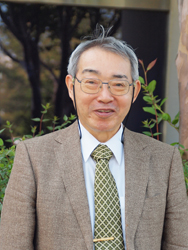
![]() DG's Corner -Damage caused by the recent earthquake and recovery prospects- (2011.5.10)
DG's Corner -Damage caused by the recent earthquake and recovery prospects- (2011.5.10)
First of all, I would like to express my deepest appreciation for the messages of concern, sympathy and encouragement that we received from all over the world since the major earthquake of March 11th. We are working to restore KEK as quickly as possible to its original condition so it can once again function as the exceptional research facility it was hitherto. Your messages do help a great deal in this difficult time.
Both the KEK-Tsukuba and KEK-Tokai (J-PARC) sites experienced tremors exceeding 6 on the Japanese seismic intensity scale, even though we are some 300 km away from the epicenter. This has caused a significant amount of damage to both facilities. ---more
![]() Accelerated Higher Intensity Heavy Ion Beam with New Linac System (2011.04.14)
Accelerated Higher Intensity Heavy Ion Beam with New Linac System (2011.04.14)
![]() Research Laboratory for Nuclear Reactors in Tokyo Institute of Technology had developed a multi-beam type RFQ (Radio Frequency Quadrupole) linac system accelerating several heavy ion beams in parallel in one cavity. This system has made it possible for generating high intensity heavy ion beams, never before possible such as 100 mA and more, without growing the machine scale. ---more
Research Laboratory for Nuclear Reactors in Tokyo Institute of Technology had developed a multi-beam type RFQ (Radio Frequency Quadrupole) linac system accelerating several heavy ion beams in parallel in one cavity. This system has made it possible for generating high intensity heavy ion beams, never before possible such as 100 mA and more, without growing the machine scale. ---more

(![]() linked 2011.04.14)
linked 2011.04.14)
![]() The Sixteenth meeting of the KEKB Accelerator Review Committee was held (2011.2.14)
The Sixteenth meeting of the KEKB Accelerator Review Committee was held (2011.2.14)
![]() The Sixteenth meeting of the KEKB Accelerator Review Committee was held on February 7-9, 2011. This was the first meeting since SuperKEKB was formally approved and funded, so the Committee has been expanded to include experts from all around the world who came to KEK to help make the project a success. ---more
The Sixteenth meeting of the KEKB Accelerator Review Committee was held on February 7-9, 2011. This was the first meeting since SuperKEKB was formally approved and funded, so the Committee has been expanded to include experts from all around the world who came to KEK to help make the project a success. ---more
*Web Album
![]() Japanese 9-cell SCRF cavity meets ILC specifications (2010.12.09)
Japanese 9-cell SCRF cavity meets ILC specifications (2010.12.09)
![]() Designing and fabricating an optimal accelerating cavity is not so simple. There are two important parameters scientists are looking for: the gradient of 35 megavolts per meter (MV/m) and the quality factor (Q0) of greater than 8×109. A Japanese cavity now fulfilled those requirements for the first time at a test which took place at the Superconducting radiofrequency Test Facility (STF) at KEK, adding momentum towards future mass production. ---more
Designing and fabricating an optimal accelerating cavity is not so simple. There are two important parameters scientists are looking for: the gradient of 35 megavolts per meter (MV/m) and the quality factor (Q0) of greater than 8×109. A Japanese cavity now fulfilled those requirements for the first time at a test which took place at the Superconducting radiofrequency Test Facility (STF) at KEK, adding momentum towards future mass production. ---more

(![]() linked 2010.12.09 / ILC Newsline linked 2010.12.09 )
linked 2010.12.09 / ILC Newsline linked 2010.12.09 )
![]() Japanese 9-cell SCRF cavity meets ILC specifications (2010.12.02)
Japanese 9-cell SCRF cavity meets ILC specifications (2010.12.02)
![]() The Japanese cavity achieved an important milestone. On 25 November, it fulfilled, for the first time, the production specifications for the International Linear Collider (ILC) in a vertical test conducted at KEK's Superconducting RF Test Facility (STF). The cavity, called MHI-013 is the 13th in a series of nine-cell cavities fabricated by Mitsubishi Heavy Industries Co., Ltd. It demonstrated the accelerating gradient of 31.5 megavolts per meter (MV/m) with an unloaded quality factor (Q0) over 1×1010, and 35 MV/m with Q0 over 0.8×1010. As 31.5 MV/m is the targeted operating gradient of the ILC, 35 MV/m allows ten percent margin for this operating gradient. ---more
The Japanese cavity achieved an important milestone. On 25 November, it fulfilled, for the first time, the production specifications for the International Linear Collider (ILC) in a vertical test conducted at KEK's Superconducting RF Test Facility (STF). The cavity, called MHI-013 is the 13th in a series of nine-cell cavities fabricated by Mitsubishi Heavy Industries Co., Ltd. It demonstrated the accelerating gradient of 31.5 megavolts per meter (MV/m) with an unloaded quality factor (Q0) over 1×1010, and 35 MV/m with Q0 over 0.8×1010. As 31.5 MV/m is the targeted operating gradient of the ILC, 35 MV/m allows ten percent margin for this operating gradient. ---more
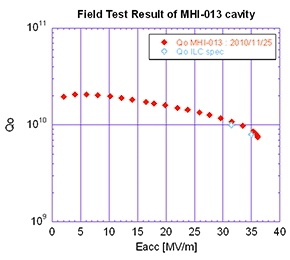
![]() Start operation of the Small Electron Linear Accelerator for calibration of the Fluorescence Detector of the Telescope Array experiment (2010.10.14)
Start operation of the Small Electron Linear Accelerator for calibration of the Fluorescence Detector of the Telescope Array experiment (2010.10.14)
![]() The Telescope Array ( TA ) experiment is a ultra-high energy cosmic rays ( UHECRs ) observation which is established in the desert area about 200 km far from Salt Lake City in Utah state, north U.S. We began the observation in April 2008. The UHECRs are the highest primary cosmic rays which have energy more than 1018 eV. However, we do not understand any fundamental features, for example the chemical composition, their generation and acceleration mechanism, and the theoretical flux limit ( GZK-cutoff ). ---more
The Telescope Array ( TA ) experiment is a ultra-high energy cosmic rays ( UHECRs ) observation which is established in the desert area about 200 km far from Salt Lake City in Utah state, north U.S. We began the observation in April 2008. The UHECRs are the highest primary cosmic rays which have energy more than 1018 eV. However, we do not understand any fundamental features, for example the chemical composition, their generation and acceleration mechanism, and the theoretical flux limit ( GZK-cutoff ). ---more

(![]() linked 2010.10.21)
linked 2010.10.21)
![]() IPAC10 Special Lectures to Commemorate the 120th Anniversary of the Birth of Yoshio Nishina 〜From TRISTAN to B-Factory〜 (2010.10.07)
IPAC10 Special Lectures to Commemorate the 120th Anniversary of the Birth of Yoshio Nishina 〜From TRISTAN to B-Factory〜 (2010.10.07)
![]() TRISTAN was the first Japanese electron-positron collider, and built in 1981-1986. The collision energy attained was 64GeV, then the highest in the world. National Laboratory for High Energy Physics(KEK) was founded in 1971 as the first national laboratory for inter-university research, and a 12GeV proton synchrotron was built in 1971-1974 as its major research facility(KEK-PS). It must be noted that the KEK-PS energy was initially proposed to be 40Gev and compelled to lower to 12GeV to cope with the government's budget cut to a quarter of the initial demand( about 30BYen). Intriguing is that the 40GeV PS plan was realized as J-PARC after almost 40 years, though the machine design was considerably different each other. ---more
TRISTAN was the first Japanese electron-positron collider, and built in 1981-1986. The collision energy attained was 64GeV, then the highest in the world. National Laboratory for High Energy Physics(KEK) was founded in 1971 as the first national laboratory for inter-university research, and a 12GeV proton synchrotron was built in 1971-1974 as its major research facility(KEK-PS). It must be noted that the KEK-PS energy was initially proposed to be 40Gev and compelled to lower to 12GeV to cope with the government's budget cut to a quarter of the initial demand( about 30BYen). Intriguing is that the 40GeV PS plan was realized as J-PARC after almost 40 years, though the machine design was considerably different each other. ---more
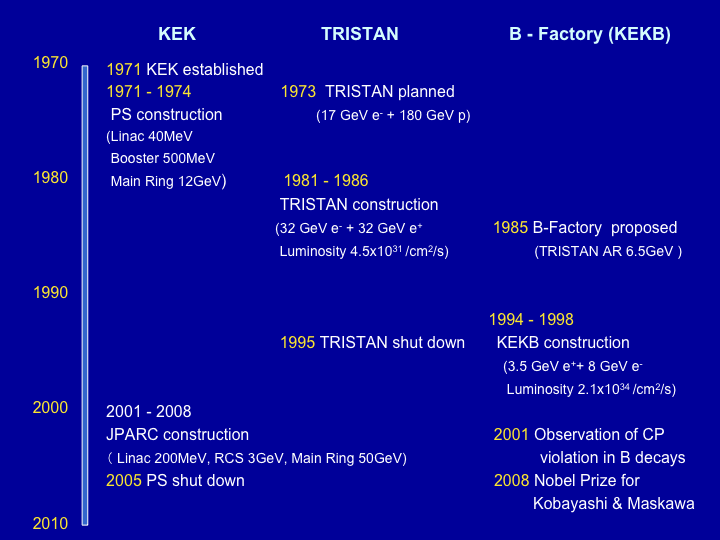
![]() The 26th OHO seminar on high-energy accelerator held at KEK (2010.10.05)
The 26th OHO seminar on high-energy accelerator held at KEK (2010.10.05)
![]() 31 August -3 September, the OHO'10 seminar was held at KEK with 45 scientists and engineers form institutes, universities and industries. The purpose of OHO seminar is to develop and deepen the interest for the accelerator science of younger generations in both academia and industries. OHO seminar has been held once a year since 1984. ---more
31 August -3 September, the OHO'10 seminar was held at KEK with 45 scientists and engineers form institutes, universities and industries. The purpose of OHO seminar is to develop and deepen the interest for the accelerator science of younger generations in both academia and industries. OHO seminar has been held once a year since 1984. ---more
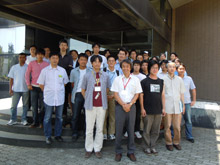
![]() NSRRC adopted KEKB-type superconducting cavity for Taiwan Photon Source project (2010.9.30)
NSRRC adopted KEKB-type superconducting cavity for Taiwan Photon Source project (2010.9.30)
![]() National Synchrotron Radiation Research Center (NSRRC) in Taiwan chose the KEKB-type superconducting cavity to be installed into the synchrotron storage ring of the Taiwan Photon Source (TPS), the third generation synchrotron light source currently under construction right next to the site of existing accelerator, Taiwan Light Source (TLS). Mitsubishi Heavy Industries, Japan, received the order to fabricate three cavities scheduled to be delivered to NSRRC in 2012. ---more
National Synchrotron Radiation Research Center (NSRRC) in Taiwan chose the KEKB-type superconducting cavity to be installed into the synchrotron storage ring of the Taiwan Photon Source (TPS), the third generation synchrotron light source currently under construction right next to the site of existing accelerator, Taiwan Light Source (TLS). Mitsubishi Heavy Industries, Japan, received the order to fabricate three cavities scheduled to be delivered to NSRRC in 2012. ---more
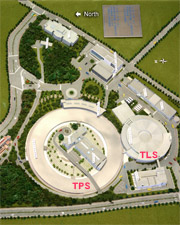
by courtesy of NSRRC
![]() The first Baseline Assessment Workshop for the ILC held at KEK (2010.9.30)
The first Baseline Assessment Workshop for the ILC held at KEK (2010.9.30)
![]() 7-10 September, the first baseline assessment workshops (BAW-1) took place at KEK with 63 scientists and engineers from around the world. ---more
7-10 September, the first baseline assessment workshops (BAW-1) took place at KEK with 63 scientists and engineers from around the world. ---more
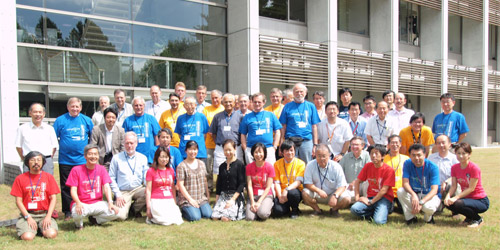
![]() Cast your vote for top Particle Physics Photowalk photograph (2010.9.28)
Cast your vote for top Particle Physics Photowalk photograph (2010.9.28)
![]() On August 7, more than 200 photographers had the rare opportunity to go behind the scenes at five laboratories in Asia, Europe and North America, as part of the first Global Particle Physics Photowalk. Thousands of photographs were submitted to the laboratories for local and global competitions. The laboratories have made their choices, each nominating three photographs for global competition. Now it’s your turn -- starting today, you may vote for up to three of your favorite photographs as part of the “people’s choice” global photowalk competition.
On August 7, more than 200 photographers had the rare opportunity to go behind the scenes at five laboratories in Asia, Europe and North America, as part of the first Global Particle Physics Photowalk. Thousands of photographs were submitted to the laboratories for local and global competitions. The laboratories have made their choices, each nominating three photographs for global competition. Now it’s your turn -- starting today, you may vote for up to three of your favorite photographs as part of the “people’s choice” global photowalk competition.
![]() KEK Openhouse 2010 (2010.9.6)
KEK Openhouse 2010 (2010.9.6)
The Openhouse was on September 5, and some 3,300 people visited.
The visitors were interested in the research activities and the facilities of KEK.
http://openhouse.kek.jp/2010/index_e.html
*Web Album
![]() SIMULTANEOUS TOP-UP OPERATION OF THREE DIFFERENT RINGS IN KEK INJECTORLINAC (2010.09.03)
SIMULTANEOUS TOP-UP OPERATION OF THREE DIFFERENT RINGS IN KEK INJECTORLINAC (2010.09.03)
![]() In KEK Tsukuba campus, the four storage rings are operated for various user experiment. KEKB electron/positron ring (3 km circumference) is utilized for the high energy physics research. PF (187 m circumference) and PF-AR (377 m circumference) rings are the powerfull devices for the material and life science researches. KEK injector linac is a 600-m-long linear accelerator, and provides the electron and positron beams of different energy for the four independent rings. ---more
In KEK Tsukuba campus, the four storage rings are operated for various user experiment. KEKB electron/positron ring (3 km circumference) is utilized for the high energy physics research. PF (187 m circumference) and PF-AR (377 m circumference) rings are the powerfull devices for the material and life science researches. KEK injector linac is a 600-m-long linear accelerator, and provides the electron and positron beams of different energy for the four independent rings. ---more
![]() Summer Challenge programme for young intelligence (2010.09.03)
Summer Challenge programme for young intelligence (2010.09.03)
About 90 students from all parts of Japan gathered at the Summer Challenge programme held at KEK, Tsukuba from 21 to 29 August 2010. Starting in 2007, this programme intended for junior students who are interested in high-energy physics was the fourth in the series this year. ---more
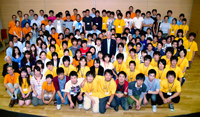
![]() The first global Particle Physics Photo Walk held at 5 world's particle physics labs (2010.09.03)
The first global Particle Physics Photo Walk held at 5 world's particle physics labs (2010.09.03)
![]() KEK took 40 photographers behind the scenes. On August 7, photographers, both amateurs and professionals visited, explored and took photos of KEK's facilities, accelerators, detectors, people and any objects interested them. They took part in the first global Particle Physics Photowalk took place on this same day around the world at five physics laboratories in five countries: CERN (Switzerland), DESY (Germany), Fermilab (USA), TRIUMF (Canada) and KEK. ---more
KEK took 40 photographers behind the scenes. On August 7, photographers, both amateurs and professionals visited, explored and took photos of KEK's facilities, accelerators, detectors, people and any objects interested them. They took part in the first global Particle Physics Photowalk took place on this same day around the world at five physics laboratories in five countries: CERN (Switzerland), DESY (Germany), Fermilab (USA), TRIUMF (Canada) and KEK. ---more
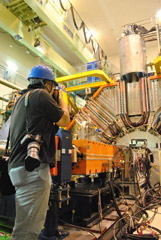
![]() The fifth POSIPOL workshop held at KEK (2010.06.10)
The fifth POSIPOL workshop held at KEK (2010.06.10)
![]() The POSIPOL 2010 workshop was held from 31 May to 2 June at KEK. It was the fifth in the POSIPOL series of workshops dealing with the physics aspects, the design issues, and the open questions concerning a polarized positron source in the framework of the next-generation electron-positron colliders such as the ILC or the Compact Linear Collider Study CLIC. ---more
The POSIPOL 2010 workshop was held from 31 May to 2 June at KEK. It was the fifth in the POSIPOL series of workshops dealing with the physics aspects, the design issues, and the open questions concerning a polarized positron source in the framework of the next-generation electron-positron colliders such as the ILC or the Compact Linear Collider Study CLIC. ---more

![]() High Field Gradient RF System for J-PARC and Upgrade (2010.06.07)
High Field Gradient RF System for J-PARC and Upgrade (2010.06.07)
![]() We, KEK, cooperate with the Japan Atomic Energy Agency (JAEA) and developed a high field gradient RF system for a proton accelerator. This system is now under operation for J-PARC. The acceleration system is the “heart” of an accelerator and it is quite important because it determines the performance of the accelerator. A newly developed accelerating system using a Magnetic Alloy enables three improvements which are not available by older type systems. These are a higher field gradient than that of classic ones, mixing of multi-harmonic RF and high accuracy of the system below a few nano-seconds. We are also developing the system further by improving the magnetic material. This way, we expect to increase the beam intensity and improve the performance of the accelerator complex. ---more
We, KEK, cooperate with the Japan Atomic Energy Agency (JAEA) and developed a high field gradient RF system for a proton accelerator. This system is now under operation for J-PARC. The acceleration system is the “heart” of an accelerator and it is quite important because it determines the performance of the accelerator. A newly developed accelerating system using a Magnetic Alloy enables three improvements which are not available by older type systems. These are a higher field gradient than that of classic ones, mixing of multi-harmonic RF and high accuracy of the system below a few nano-seconds. We are also developing the system further by improving the magnetic material. This way, we expect to increase the beam intensity and improve the performance of the accelerator complex. ---more
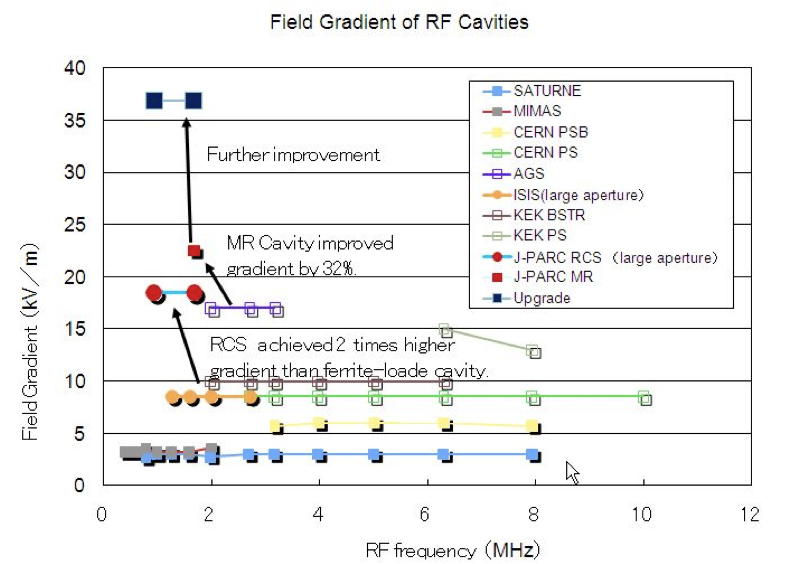
![]() The 15th KEKB Accelerator Review Committee was held (2010.02.18)
The 15th KEKB Accelerator Review Committee was held (2010.02.18)
![]() The Fifteenth KEKB Accelerator Review Committee meeting was held on February 15-17, 2010. Appendix A shows the present membership of the Committee. The Committee was as always impressed by the high standard of the talks, both the technical content and the presentations themselves.
The Fifteenth KEKB Accelerator Review Committee meeting was held on February 15-17, 2010. Appendix A shows the present membership of the Committee. The Committee was as always impressed by the high standard of the talks, both the technical content and the presentations themselves. 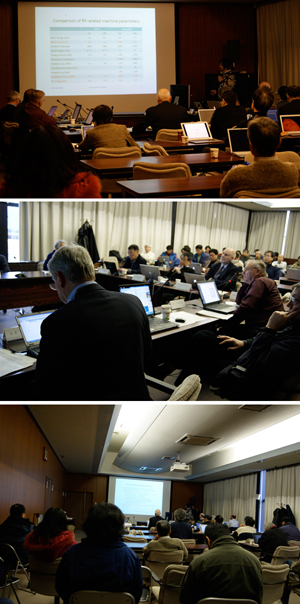
![]() 1st Joint Asian Accelerator Workshop held in China(2010.01.18)
1st Joint Asian Accelerator Workshop held in China(2010.01.18)
22-23 December, the Joint Asian Accelerator Workshop (JAAWS) was held at the Institute of High Energy physics (IHEP), in Beijing, China, as the first step for establishing a new initiative to promote stronger and more effective collaboration on R&D works in accelerator science and its application. The directors and leading scientists from core laboratories in five Asian countries - China, India, Japan, Korea and Russia - have gathered at a kickoff workshop to seek for possible future collaborations. ---more
![]() KEKB/Belle integrated luminosity reached 1000 fb-1(2009.12.18)
KEKB/Belle integrated luminosity reached 1000 fb-1(2009.12.18)
AT KEKB B-Factory, the total integrated luminosity accumulated by the Belle detector reached 1000 fb-1 on November 29th 2009, which was the initial goal of the KEKB project.
The Belle detector was installed in the KEKB accelerator in May 1999. This new record has been accomplished ten and a half years after the installation. The accumulation of 1000 fb-1 has been achieved for the first time in the world, while KEKB has been being operated with the world highest peak luminosity. The figure shows the history of the integrated luminosity at KEKB/Belle. It may seem that the accumulation has been achieved relatively smoothly. In reality, however, this has been done with various efforts such as those for increasing beam currents by overcoming a number of vacuum troubles and those for suppressing the effects of the electron clouds by installing solenoid coils all around the positron ring. To accumulate the integrated luminosity at a higher rate, it is important to lower the frequency of machine troubles and to keep the beams stably without beam aborts, in addition to raising the peak luminosity. In this sense, the achievement of this record is the fruits of the efforts of all members who have been concerned with KEKB including the staff of the facility division or the injector.
(▲KEK web![]() )
)
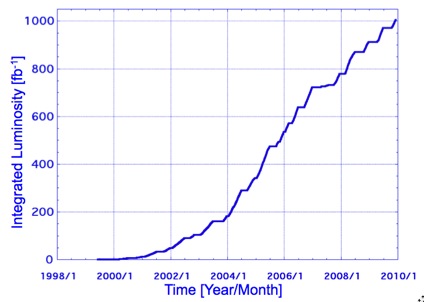
![]() Openhouse 2009 (2009.9.9)
Openhouse 2009 (2009.9.9)
The Openhouse was on September 6, and some 3,900 people visited.
The visitors were interested in the research activities and the facilities of KEK.
https://www2.kek.jp/openhouse/2009/index-e.html
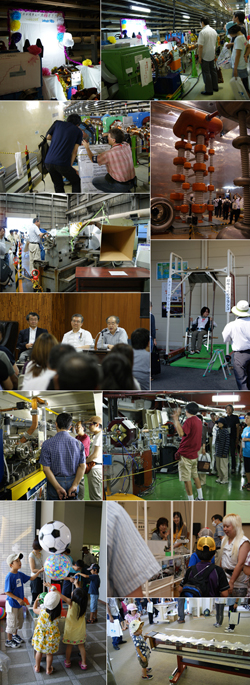
[Click image for larger view 752KB]
![]() Using Crab Cavities, KEKB Breaks Luminosity World Record (Current operation summary) (2009.6.18)
Using Crab Cavities, KEKB Breaks Luminosity World Record (Current operation summary) (2009.6.18)
Peak Luminosity2.1083 x 1034 cm-2 s-1 (2009.6.17 17:12)
Daily Integrated Luminosity 1.4794 /fb (2009.6.14)
![]() Proton beam reaches neutrino target at J-PARC (2009.4.23)
Proton beam reaches neutrino target at J-PARC (2009.4.23)
At 19:09 on April 23, J-PARC has reached a new milestone with successful extraction of proton beam to a neutrino target.
The proton beam accelerated to 30 GeV in the J-PARC Main Ring was extracted and transported through the beam line which has 14 superconducting dipoles and then hit on the neutrino target.
This achievement denotes the start of challenge to send high-power neutrino beams to the Super-Kamiokande detector which locates 295 km west from the J-PARC cite for long baseline neutrino oscillation experiment.(J-PARC)
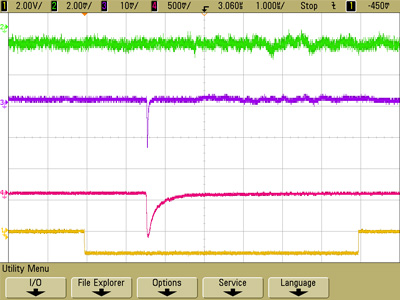
![]() Protons are successfully accelerated and transported to J-PARC Hadron Experimental Hall
Protons are successfully accelerated and transported to J-PARC Hadron Experimental Hall
A new milestone was set by the 50 GeV Synchrotron, which is the 3rd and the last stage of the accelerators of the Japan Proton Accelerator Research Complex (J-PARC), on January 27, 2009. Protons were accelerated up to 30 billion electron-volts (30 GeV), then successfully extracted to Hadron Experimental Hall in Nuclear and Particle Physics Facility and transported to the beam dump. (2009.1.28)
![]() ATF2 for R&D of nano-meter electron beam has been started(2009.1.9)
ATF2 for R&D of nano-meter electron beam has been started(2009.1.9)
A new beamline for R&D toward nano-meter electron beam has started operation at KEK's Accelerator Test Facility - ATF.
|
|
|
![]() MR: Successful injection of 3GeV proton beam, RF captured and extraction
MR: Successful injection of 3GeV proton beam, RF captured and extraction
At 22:27 of May 22nd 2008, the 3 GeV proton beams from the RCS (3GeV proton synchrotron) were successfully injected into the Main Ring (50GeV proton synchrotron). The beam was captured by RF and extracted to the beam dump after 1000 turns. The day after, the beam storage time was extended up to 1 second. It is the major milestone for the J-PARC. The next step is to accelerate beams to 30GeV (Phase I) and to extract beams to the experimental holes, which will start in the end of this year. (by nh 2008.5.27)
![]() Prof. Ohmi is recognized as one of the Outstanding Referees of Physical Review (08.03.27)
Prof. Ohmi is recognized as one of the Outstanding Referees of Physical Review (08.03.27)
Peak Luminosity2.40×1034cm-2s-1 (2020.6.21 0:53) Peak Luminosity2.1083 x 1034 cm-2 s-1 (2009.6.17 17:12) Daily Integrated Luminosity 1.4794 /fb (2009.6.14) | |
|
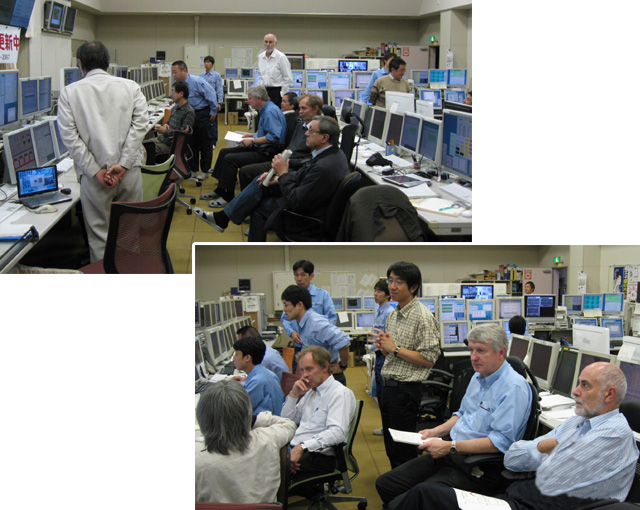 |
|




